If you are reading these rules for the first time, ignore the text along the right hand side. These rules serve as a summary to help you quickly familiarize yourself with the game.
You are the founder of a new village during the middle ages, in the
years after a great plague. The loss of so many people has created big
problems for the survivors. Many of the people the villagers used to
depend on for essential things like food, shelter and clothes are gone.
Craftsmen find themselves without suppliers of raw materials, traders
have lost their customers and many have lost their farms and
workshops as they escaped the plague.
The roads are full of refugees seeking a new beginning. They come to
you, hoping to settle down on your land and make a living. Your grain
farm is the ideal starting point for a village, reliably providing food for
many people. You must choose wisely who you allow to settle with
you, as your food and resources are limited.
The people on the road have valuable and unique skills, but they all in
turn rely on other people with very specific crafts to be able to work.
Raw materials, tools and services must be provided by other people
from the road.
If you manage to find people that can work together to make
a profit, while increasing your food surplus and capacity for
building new houses, your village will be prosperous.
-
Remove the
Wool and
Leather cards when playing with fewer than 4 players.
-
Place the 6
Starting Road Villagers and the 3 stacks of
Basic Villagers.
-
Shuffle the
Villagers cards and deal 6 stacks of cards above the
Road,
each with a number of cards equal to
twice the number of players.
-
Put the
First Market Card under the second stack, and the
Second Market Card under the sixth.
-
Give each player 8
Gold, a
Founders card in their
Village, and 5 random cards face-down in their
Hand.
-
Place the remaining cards in a seventh stack called the
Reserve.
 1
Find the 6
Starting Road Villagers marked with
1
Find the 6
Starting Road Villagers marked with
 and place
them face-up in a line in the centre of the table. This is the
Road.
and place
them face-up in a line in the centre of the table. This is the
Road.
On
Yucata.de, the starting villagers are not marked with

.
2
Find the 10
Hayers, 10
Lumberjacks and 10
Miners and place
them face-up in separate stacks.
 3
Give each player a
Founders card and place it with the 2
Gold side
facing up. The
Founders card forms the start of each
Village.
3
Give each player a
Founders card and place it with the 2
Gold side
facing up. The
Founders card forms the start of each
Village.
4
Give each player a
Village Square and place it next to their
Village.
5
Give each player 8
Gold*, this is their starting
Supply. Place the
rest of the
Gold in an area next to the
Road to form the
Bank.
6
Give the
First Player Card to the player who has lived in the same
place the longest.
7
If it's a 2 or 3 player game: remove the cards marked with
4+,
those are the
Wool and
Leather suits.
8
Shuffle the rest of the cards and form 6 face-down stacks each
with twice as many cards as there are players in the game. In a 5
player game for example you would make 6 stacks with 10 cards
in each. Line these stacks up above the
Starting Road Villagers.
9
Add the
First Market Card beneath the second stack, and the
Second Market Card beneath the sixth stack. The
Road is now
complete.
10
From the remaining cards deal 5 cards face-down to each player.
These are the
Player Hands.
11
Place the rest of the cards in a stack next to the
Road, this is
called the
Reserve.
Take note of the different rules for 2 players.
That's it, the game is now ready to be played.
*
Gold is the collective term for the currency used in the game, no
matter what colour the coins are.
Food Symbol
Builder Symbol
Suit Symbol
Card Stacking Hint
Production Chain Text
Villager Name
Gold Symbol
Banner
Padlock
Unlocking Symbol
Silver Formula
Keyring Symbol
Signpost Symbol
Card backs
Discard Symbol
Food Symbol: Each of these lets you draft an
extra villager in the
Draft Phase.
Builder Symbol: Each of these allows you to place
an extra villager in the
Build Phase.
Suit Symbol: Tells you which of the 9 suits this villager belongs to.
Most villagers need to be placed on top of specific villagers of the
same suit.
Card Stacking Hint: Shows how many villagers can be stacked on
top of this one if any. In this case just one.
Production Chain Text: Tells you what villagers this one has to be
placed on top of, and what villagers can be placed on top of this
one, if any.
Villager Name: The occupation of the villager.
Gold Symbol: This tells you how much
Gold this villager earns in
the
Market Phases.
Gold is victory points in this game.
Banner: Tells you the name of the suit. Only villagers that can go
straight onto the table with no other villagers underneath have
banners.
Padlock: Shows you that this villager has a
Padlock.
Unlocking Symbol: Names the villager that unlocks the
Padlock on
this one.
Silver Formula: Describes a conditional amount of points this
villager will earn you in the
Second Market Phase.
Keyring Symbol: Tells you how many other villagers this one can
unlock with the
Padlock Mechanic.
Signpost Symbol: Tells you this villager is one of the 6 villagers
placed face-up on the
Road at the beginning of the game. Only
matters when setting up the game, and when packing up.
Card backs: These show what suit the villager belongs to. Useful
when you draft face-down villagers or want to guess what the
other players have in their hands.
Discard Symbol: Tells you this card is discarded after playing.
Each round consists of two phases, a
Draft Phase and a
Build Phase.
Twice per game there will be a
Market Phase, where players earn
Gold. The second of these occurs at the end
of the round in which all six face-down stacks of cards on the
Road are emptied, after which the game ends.
The player with the most
Gold is the winner.
The game is played over several rounds until all the face-down stacks
of villager cards on the
Road
A have been emptied. Each round is
divided into 2 phases carried out in order:
-
The Draft Phase: players draft villagers from the Road.
-
The Build Phase: players play villagers from their hand into their
Villages B.
In addition there are 2
Market Phases in the game, where players
earn
Gold. Whoever has the most
Gold
C at the end of the game is
the winner.
Players take turns drafting villagers one at a time up to their
Drafting Limit
(2, plus 1 for each
Food, max 5). Players
must draft up to their
Drafting Limit.
Each turn you will draft 1 card and put it into your
Village Square. You may draft a face-up card
from the
Road, in which case you take any
Gold placed on it, or you may draft a face-down card
from any stack, in which case you reveal it when you put it in your
Village Square. When you have
cards in your
Village Square equal to your
Drafting Limit, you take them into your hand and sit out the rest of the
Draft Phase.
Cards drafted from the face-up
Road are immediately replaced by the top card of the leftmost stack.
Once a stack is emptied, it is no longer in the game.
The Reserve can only be drafted from when all other stacks are empty.
Once all stacks including the
Reserve are empty, cards drafted from the
Road are no longer replaced.
In this phase players take turns to take (or "draft") villagers from the
Road. They may draft any of the face-up villagers from the
Road, or
blindly draft the top card from any of the stacks.
You must draft 2 villagers, plus 1 for each Food  in your Village.
This is called your
Drafting Limit. If you have 1
Food for example, you
must draft 3 villagers.
You can never draft more than 5 villagers,
even if you have 4 or more Food.
in your Village.
This is called your
Drafting Limit. If you have 1
Food for example, you
must draft 3 villagers.
You can never draft more than 5 villagers,
even if you have 4 or more Food.
Draft one villager, then the next player in clockwise order drafts a
villager.
The player with the
First Player Card goes first. The villagers
you draft are placed face-up on your
Village Square
D. Keep drafting
in rounds until you have as many villagers on your
Village Card as
your
Drafting Limit, then take your new cards up to your hand. When
all players have drafted up to their limit, continue with the next step,
Updating The Road.
If the card you draft has a coin (placed, not printed) on it, take the
coin to your
Supply. When drafting from the face-up cards,
immediately replace the card with the top card of the leftmost
stack
E.
Do not draft or move the
Market Phase Cards
F, these should
remain in their place until the
Market Phase.
When a stack is
emptied, the stack is no longer in the game.
Near the end of the game when all stacks are emptied, use cards
from the
Reserve instead to replace the face-up cards on the
Road.
Players may draft face-down cards from the top of the
Reserve only
when all other stacks are empty. If the
Reserve and all stacks are
empty, no cards are replaced.
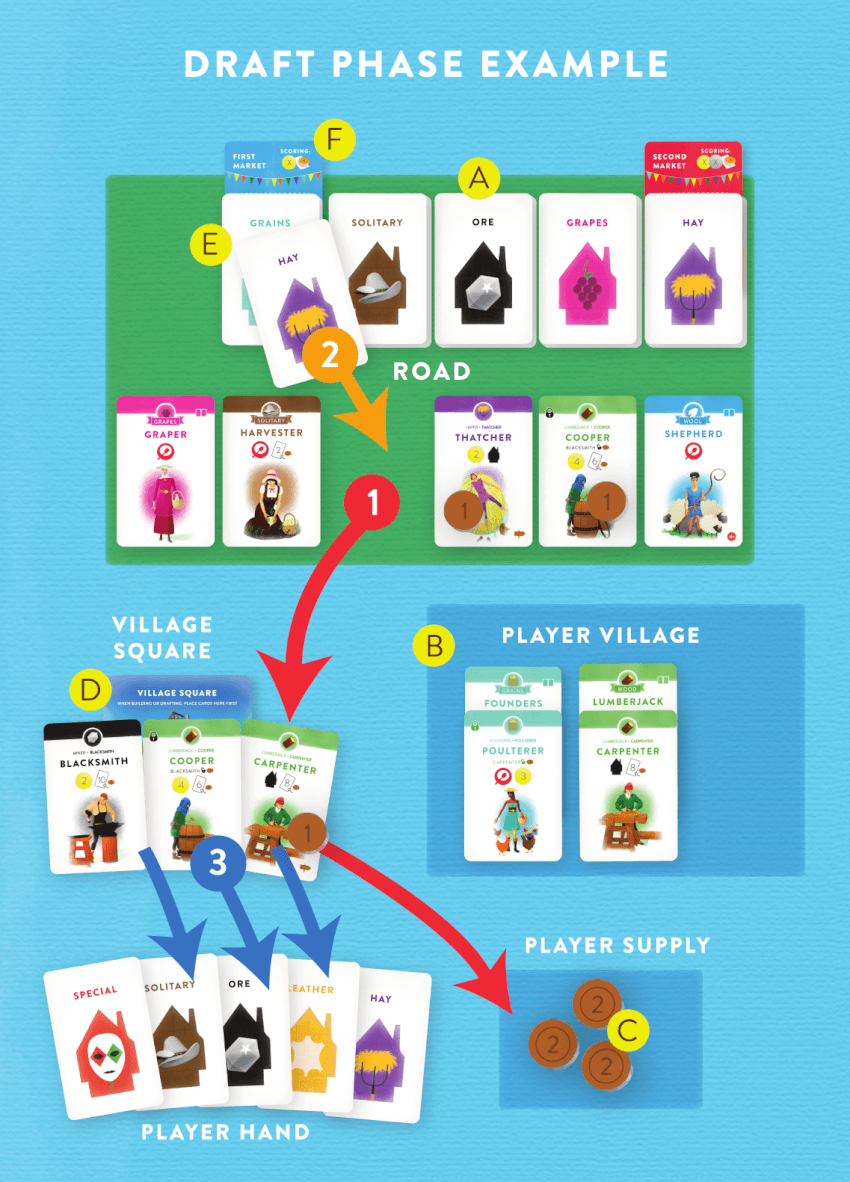
1 The player takes a villager from the
Road to their
Village Square.
The coin on it goes to their
Supply.
2 The villager is replaced with the top card of the leftmost stack.
After this it's the next player’s turn to draft.
3 As the player has 1 food in their
Village, their
Drafting Limit is 3.
When the player receives their third card, they must pick their new
cards up to their hand and stop drafting.
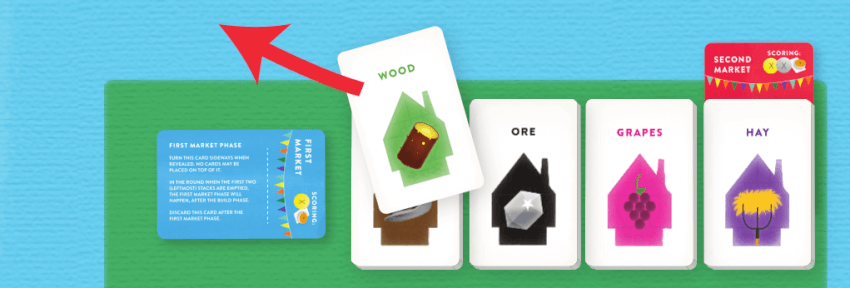
You can take a top card from one of the stacks instead of a face-up
villager. Though you draft the card face-down you flip it over and
place it face-up on your
Village Square for everyone to see.
With 2 players
After both players are done drafting:
-
In
reverse turn order, players may place 1
Gold on a face-up villager on the
Road.
-
Discard any villagers on the
Road
without coins on them.
-
Deal new cards to replace them
from the Reserve.
No other
Gold is added to villagers during this step.
Cards with coins on them can stay several rounds, and coins can
accumulate on the same villager.
After both players are done drafting do the following:
1 Each player in reverse turn order may choose to place 1
Gold
from the Bank on a villager on the
Road. You are allowed to place
Gold on
the same villager, or not place any
Gold if you wish.
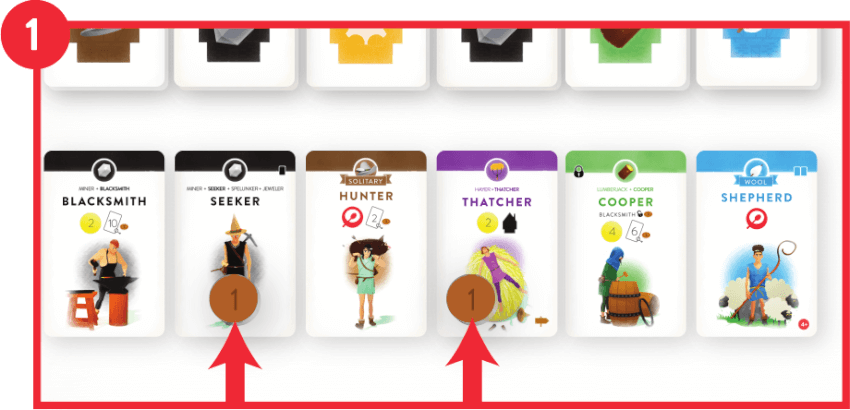
2 Discard all face-up villagers on the
Road with no coins on them.
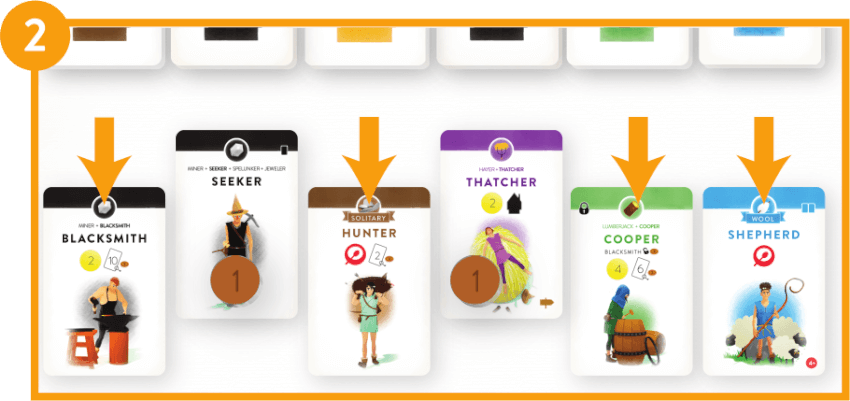
3 Deal new cards to replace the discarded Villagers
from the Reserve. If the
Reserve is empty, deal cards from the leftmost stack
on the
Road.
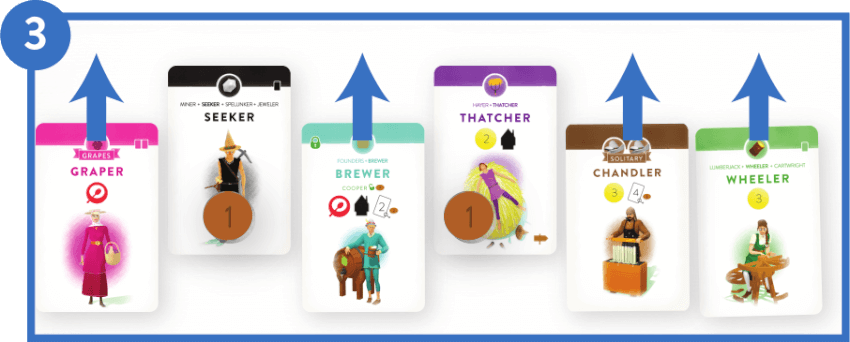
4 Start the
Build Phase.
Cards with coins on them can stay several rounds, and coins can
accumulate on the same villager.
Each player in turn does all their actions for the Build Phase:
-
Place villagers into their
Villages up to their
Build Limit (2, plus 1 for each
Builder, max 5). Players may choose to play fewer villagers than their
Build Limit if they wish.
Padlocks must be unlocked.
-
Return villagers to the stacks on the Road in exchange for Basic
Villagers (max 3).
-
Play
Special villagers. Those that are discarded do not count towards
the
Build Limit.
At the end of the
Build Phase, the
First Player Card is passed
clockwise to the next player.
Your
Build Limit is set at the start of your turn.
In this phase players take turns placing villagers from their hands into
their own Villages. Once a villager has been placed, you cannot pick it
up again.
The players can by default place 2 villagers, plus
one extra for each
Builder
 in their Village at the
beginning of the
Build Phase. If you
have 2 Builders in your
Village for example you can place 4 villagers.
This is called your
Build Limit.
You can never place more than 5 villagers, even if you have 4 or more Builders.
You can play fewer
villagers than your
Build Limit if you wish.
in their Village at the
beginning of the
Build Phase. If you
have 2 Builders in your
Village for example you can place 4 villagers.
This is called your
Build Limit.
You can never place more than 5 villagers, even if you have 4 or more Builders.
You can play fewer
villagers than your
Build Limit if you wish.
Each player finishes all their actions in the
Build Phase before passing
to the next player.
At the beginning of your
Build Phase,
tell the other players how
many Villagers you're allowed to place. Put all the villagers you
intend to use on your
Village Square card, before you place them in
your
Village. This makes it easy for everyone to keep track of how
many villagers you’re placing, making sure you don’t go over your
Build Limit.
PRODUCTION CHAINS
Each villager either forms the start of a
Production Chain, or is placed on top
of specific other villagers listed in its
Production Chain Text, in the exact order listed.
Everything below the name of a villager is covered up when the next villager in the
Production Chain
is placed on top of it. Any symbols
below the name of a covered villager are no longer in play.
You may build a
Production Chain over multiple turns.
The cards in a
Production Chain must be played in order, starting with the first card.
The first villager in a
Production Chain can have up to 2 villagers on top of them.
These can be the same or different.
You are allowed to have 2 or more of the same villager in your
Village.
If a villager has a
Production Chain Text
A on top of the card, it must
form part of a
Production Chain when placed. Any villagers listed
before the villager's own name must be placed beneath it
in the order listed.
A
Cartwright for example, must be placed on top of a
Lumberjack and
Wheeler.

A
When placing cards on top of each other, place them
so that everything below the name of the card beneath is covered up. Once
a card has been covered by another, the symbols
below its
Villager Name are no longer in play. If you cover your
Founders with a
Swineherd for example, you can no longer use the
Food or
Gold on
the
Founders.
The
Production Chain does not have to be finished right away. You
could for example place a
Lumberjack and
Wheeler in turn one, then
place the
Cartwright on top in a later turn. The cards have to be
placed in order though, you have to play the first card in a chain first,
then the second and so on.
The first villagers in a
Production Chain can have up to 2 villagers on
top of them, creating 2 branches in the same
Production Chain. A
Lumberjack for example can have a
Carpenter and a
Wheeler on top,
and the
Wheeler's Production Chain might later be extended with a
Cartwright.
You are allowed to have 2 or more of the same villager in your
village if you wish.
BUILD PHASE EXAMPLE
The player wants to play their Cartwright. As the Production Chain
Text shows, it must be placed on top of a Lumberjack and a Wheeler.
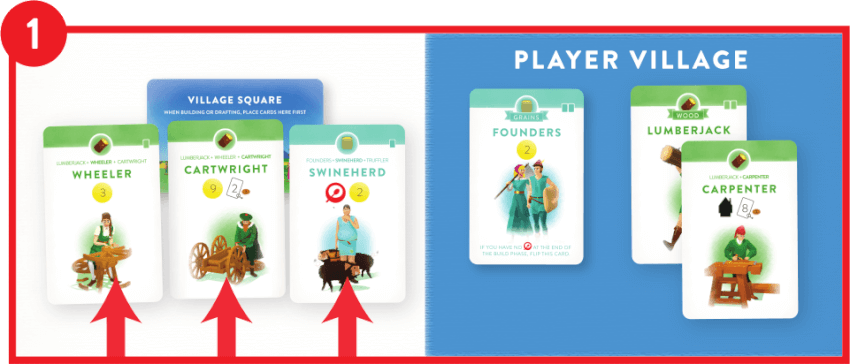
1
The player has a Wheeler in their hand, and a Lumberjack
already placed in the Village, so getting the Cartwright out will not
be a problem. They decide to play the Wheeler and Cartwright. As
the player has one Builder in their Village, they may also play a
third card. They decide to play the Swineherd, as it can be placed on
top of the Founders already in the Village. The player places these 3
cards on their Village Square, to show the other players what is
going on.
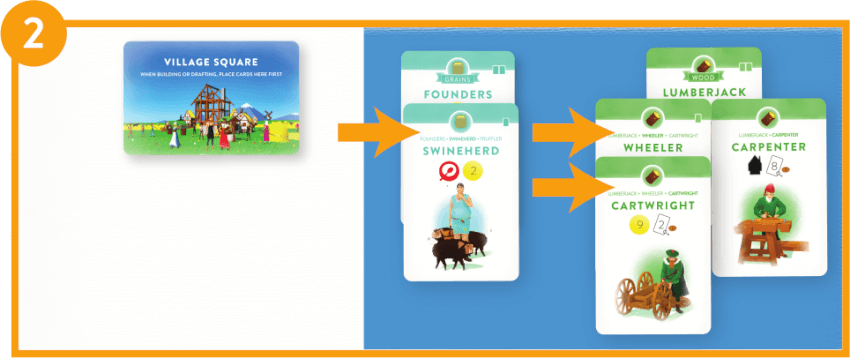
2
The player places the three cards into the Village. The Swineherd
goes on top of the Founders as its Production Chain Text demands.
The Wheeler goes on top of the Lumberjack already used by the
Carpenter, they now share his lumber production. Finally the
Cartwright goes on top of the Wheeler.
Villagers that form the start of a Production Chain like the Founders,
Lumberjacks and Shepherds can have 2 villagers placed on top of
them, branching out into two different (or identical) businesses.
GETTING BASIC VILLAGERS
Lumberjacks,
Hayers, and
Miners (the base villagers in the
Wood,
Hay and
Ore suits) are called
Basic Villagers and are acquired separately.
To get a
Basic Villager,
return a villager from your hand to one of the stacks on the
Road.
You can do this up to
three times per
Build Phase; it doesn't count
toward your
Build Limit.
In the
Build Phase you can also get
Basic Villagers. Those are
Lumberjacks,
Hayers and
Miners. All the villagers in the
Wood,
Hay and
Ore suits need to be placed on top of these. To get a
Basic Villager,
first return a villager from your hand to one of the stacks on the
Road, then take a
Basic Villager of your choice and place in your
Village. You can do this up to
three times per
Build Phase. You don’t
have to show the other players the fronts of the returned cards.
On
Yucata.de, you first pick the
Basic Villager, then choose a card in your hand to return
to a stack.
If the stacks on the
Road are all empty (as they will be in the last
Build Phase), return villagers to the top of the
Reserve instead. If that
is empty as well, discard the returned villagers.
Basic Villagers
do not count towards your Build Limit when placed in
your
Village, and neither do they count towards your maximum
Build Limit
of 5 villagers. They have nothing to do with your
Build Limit!
GETTING BASIC VILLAGERS EXAMPLE
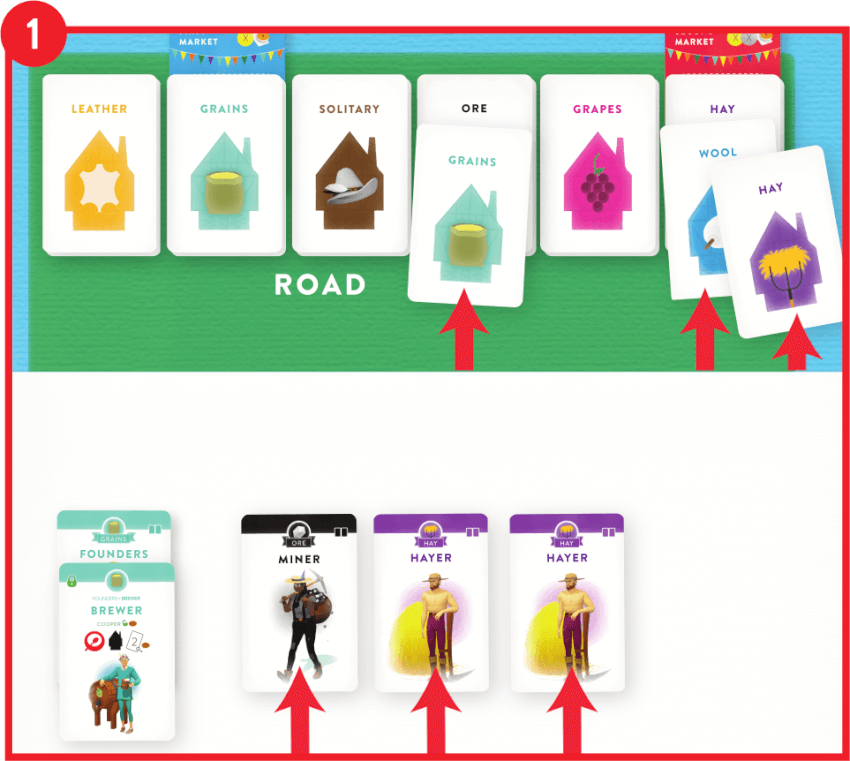
1
The player returns 3 villagers to the stacks of their choice on
the Road. Then they place 3 Basic Villagers of their choice into
their Village.
2
The player then does their 3 Build Actions, placing a Blacksmith
on the new Miner, a Grazier on one of the Hayers, and finally a
Chandler. The Chandler is a Solitary Villager and so does not go on
top of any other villager.
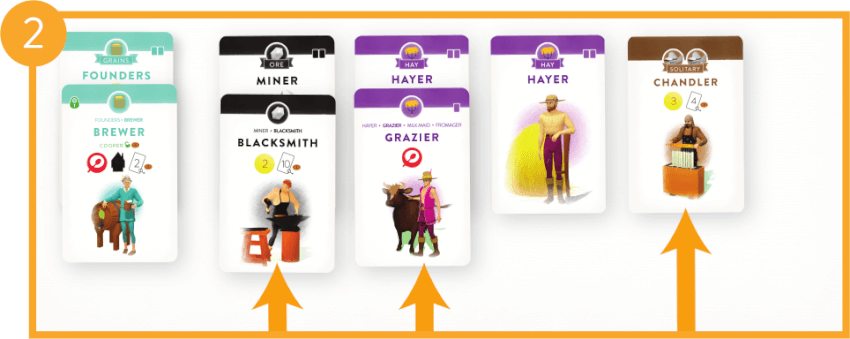
PADLOCKS
A villager with a
Padlock icon must be unlocked to be played.
To unlock it, you must do one of the following based on the
Unlocking Villager:
-
If you have the
Unlocking Villager in your own
Village,
take 2 Gold
from the Bank to put on that villager.
-
If another player has the
Unlocking Villager in their
Village,
pay 2 Gold
from your Supply onto that villager.
-
If no one has the
Unlocking Villager, pay 2 Gold
from your Supply to the Bank.
When there are multiple copies of the
Unlocking Villager, you may choose which to pay.
Unlocking Villagers have a Keyring icon showing how many total cards
in a 4‑5 player game require paying them.
When playing a villager with a
Padlock
A, you must first unlock it.
Check if you or any other player has the villager named next to the
Unlocking Symbol
in their Village. This is called the
Unlocking Villager
B.

A
B
-
If you have the
Unlocking Villager
in your own Village,
place 2 Gold from the Bank on that villager.
-
If
another player has the
Unlocking Villager,
place 2 Gold from your Supply on it.
-
If no one has the
Unlocking Villager, you must
pay 2 Gold to the Bank to unlock the villager you’re placing.
If several copies of the
Unlocking Villager are available, you get to
choose which one you pay. You cannot choose to pay the
Bank if the
Unlocking Villager is present in another player's
Village. Also note
that you could use a villager you just placed in
the current Build Phase to unlock another villager you’re playing.
See example below.
UNLOCKING PADLOCKS EXAMPLE
The player is going to place a Cooper, Brewer, and a Fisher in their
Village. They all have Padlocks.
1
First the player places the Cooper. The Unlocking Villager on the
Cooper is the Blacksmith, so the player pays another player’s
Blacksmith 2 Gold.
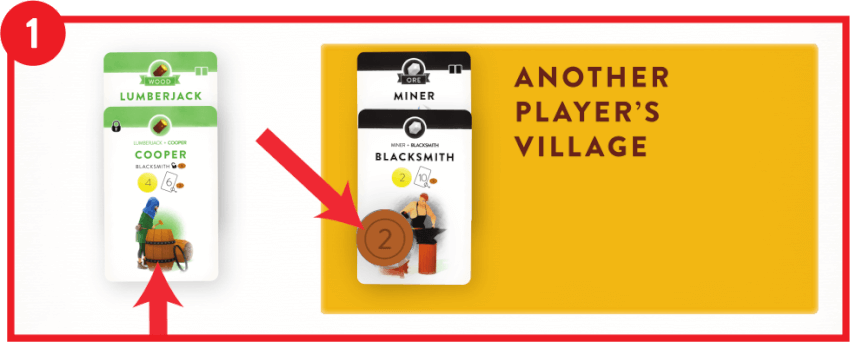
2
Next the player places the Brewer. This one is unlocked by the
Cooper, so the player pays his own recently placed Cooper 2 Gold
from the Bank.
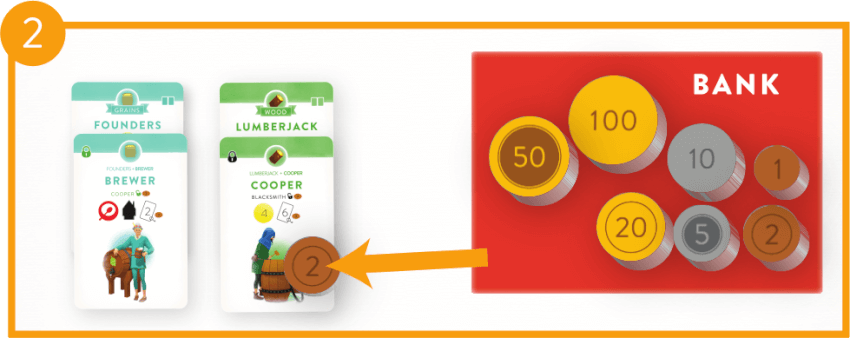
3
Finally the player places the Fisher, it requires that a Shipwright
gets paid. There are no Shipwrights in any Village, so the player
pays 2 Gold from their Supply to the Bank.
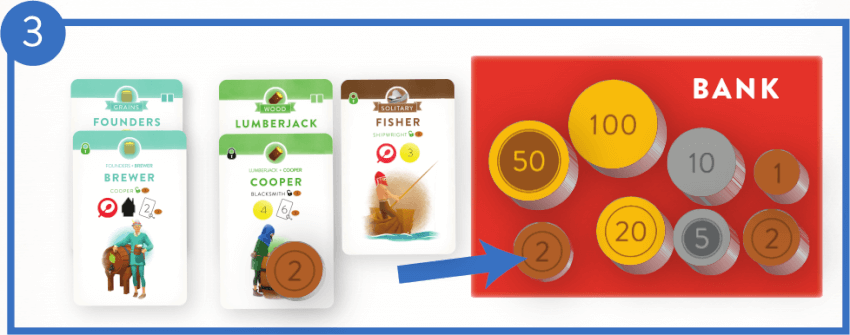
THE KEYRING SYMBOL
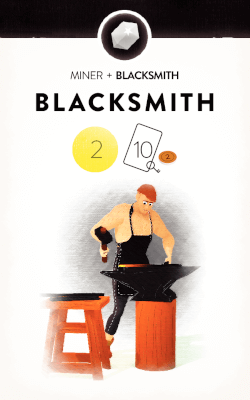
A
The number in the Keyring Symbol A
tells you how many villagers there are
in the game that have to pay this
Villager gold to be unlocked.
The Blacksmith for example can
potentially unlock 10 villagers and
accumulate up to 20 Gold in this way.
PLAYING SPECIAL VILLAGERS
Special Villagers give you powerful special actions to play in the
Build Phase. Their rules are printed on the cards.
Special Villagers with a
Discard Symbol are discarded immediately after use instead
of being placed into your
Village, and do not count towards your
Build Limit.
Special Villagers
cannot be used to steal
another player’s Founders.
You can also play the red
Special villagers on your turn
in the Build Phase.
These give you powerful special actions. Their rules are printed on the cards.
Special Villagers that have a
Discard Symbol
A are discarded
immediately after use, they
do not count towards your
Build Limit.
You can play as many of them as you want!
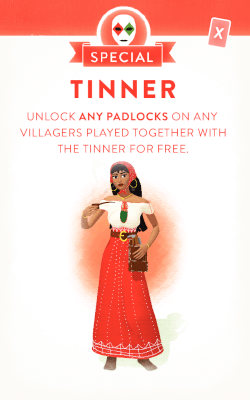
A
Special Villagers that
do not have the
Discard Symbol, like the
Monk,
do count towards your
Build Limit as they are placed in Villages when
played.
Special Villagers
cannot be used to steal
another player’s Founders.
SPECIAL VILLAGERS EXAMPLE
The player will play a Monk and a Jeweler. This brings them to their
Build Limit of 2 villagers. In addition they will play a Smuggler and a
Tinner. These two will be discarded after use and so do not count
towards the Build Limit.
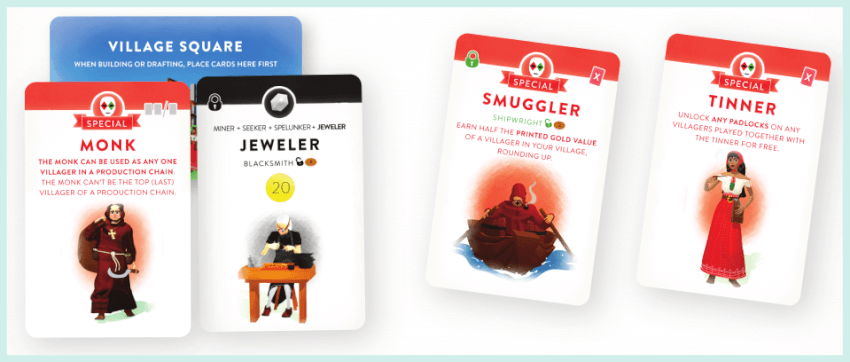
1
The Monk is kind of a “wild” villager in this game, so the player
uses him to take the place of a Spelunker between the Seeker and
Jeweler.
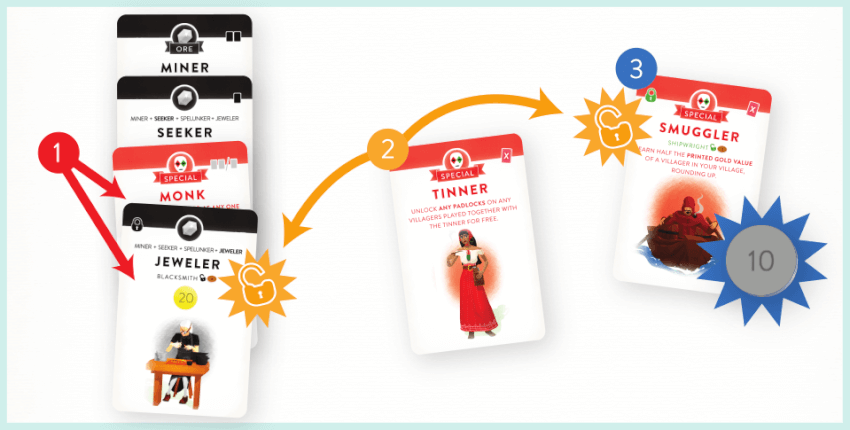
2
Next he uses the Tinner to unlock the Padlock on the Jeweler, as
it lets you unlock any Padlocks for free.
3
The player also plays the
Smuggler to earn half the value of the Jeweler, immediately
earning 10 gold. The Smuggler also has a Padlock, the player uses
the Tinner to unlock it for free. Finally the player discards the
Tinner and Smuggler.
END THE BUILD PHASE
At the end of any
Build Phase, if you have
no Food in your
Village,
flip your
Founders Card over to the side with one
Food. (It will never flip back
to the side with
Gold.)
The
First Player Card passes to the left. Then start the next
Draft Phase,
unless a
Market Phase has been triggered.
When all players are done with their
Build Phase, check if any players
have
no Food in their
Village. Players with no
Food in their
Village
after the
Build Phase
have to flip their
Founders Card
A over to the
other side that has one
Food on it. Once flipped to that side, the
Founders can never be flipped back to the side with
Gold on it.

The player has no Food in their Village, and must flip their Founders
over to the Food side.
Finally the player with the
First Player Card passes it to the player
on their left, and the
Build Phase is over. Start the next
Draft Phase,
unless a
Market Phase is triggered.
When the two leftmost stacks on the
Road are emptied,
the
First Market Phase will occur after the current round's
Build Phase.
In the
First Market Phase, players earn
Gold from the
Bank
for
Gold symbols printed on their villagers plus coins placed on them.
Take this total amount from the Bank; the coins will remain on the villagers.
Silver Symbols do not pay out in the
First Market Phase.
When the two first (leftmost) stacks on the
Road are emptied,
The First Market Phase happens after that turn's
Build Phase. The First
Market Phase Card
B is a reminder of this.*
In the
First Market Phase all players earn as much
Gold as printed on
the cards in their
Village, plus as much as the coins placed on them.
Do not pick up the coins placed on the cards, as they will be scored
again in the
Second Market Phase.
Only the top card of each
Production Chain is included,
Gold Symbols
covered by other cards do not earn any Gold.
Each player in turn order takes the
Gold they earned from the
Bank
and places it in their
Supply.
Silver Symbols
do not give you any
Gold
in the
First Market Phase. When all players are done earning their
Gold, the
First Market Phase is over. Discard the
First Market Card
and start the next
Draft Phase.

The first two stacks have been emptied, meaning there will be a
Market Phase at the end of this round. The Market Card has been
turned to the side to remind players not to place cards on it.
*Unless the players have played in a very unusual way (exclusively
drafting face-down cards) the
First Market Phase will happen in the
round when the
First Market Phase Card is revealed on the
Road.
FIRST MARKET PHASE EXAMPLE
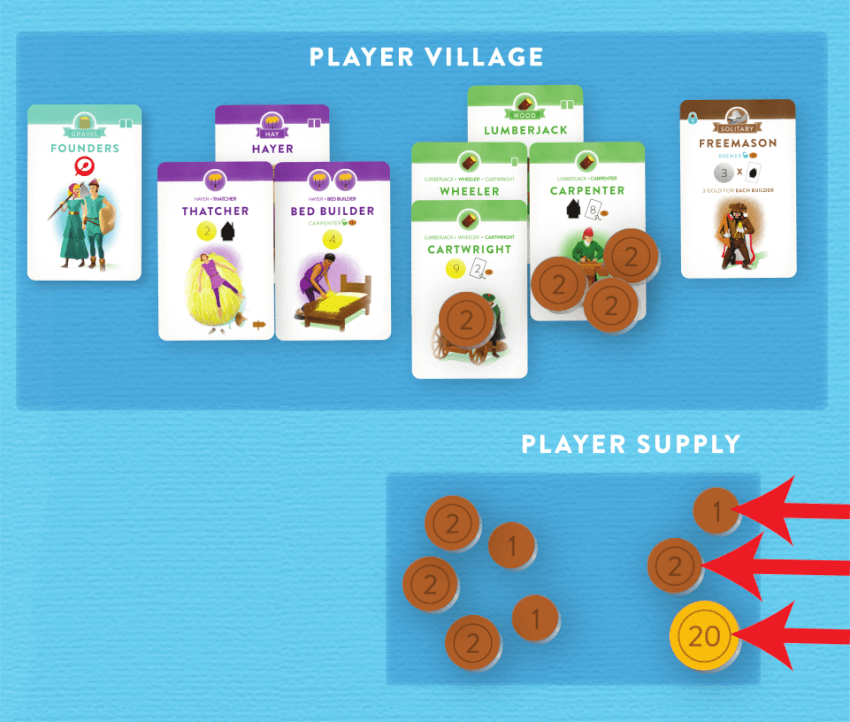
It’s the player’s turn in the Market Phase. All they have to do is add up
the numbers on the visible Gold symbols in their Village, plus the
coins on the villagers. They ignore the Freemason as his Silver Symbol
only scores in the Second Market Phase. They earn a total of 23 Gold.
They take 23 Gold from the Bank and add it to their Supply.
Note that the coins on the villagers are not removed, as they will be
scored again in the Second Market Phase.
SILVER SYMBOLS
Silver Symbols include a conditional amount of
Gold to be earned, as described on the cards.
Only your own villagers are taken into account when scoring these.
Food,
Builders and
Gold Symbols covered by other cards are not
included in the
Silver scoring, while
Suit Symbols and
Padlocks
(which appear on the tops of the cards)
are included.
Some cards have
Silver Symbols
A on them and a description of a
conditional amount of Gold to be earned. The rules for each of these
villagers are written on the cards.
Only your own villagers are taken
into account when scoring these. A
Grocer for example only scores
Food Symbols in your own Village.
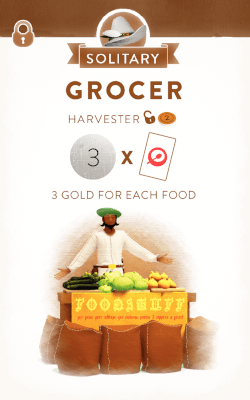
A
The reason these have
Silver instead of
Gold Symbols is because
some card effects only affect
Gold and not
Silver. A
Wood Carver for
example scores the value of the Shipwright's
Gold Symbol, but it does
not score the value of the Log Rafter's
Silver Symbol.
Food,
Builders and
Gold Symbols covered by other cards are not
included in the
Silver scoring. The
Suit Symbols and
Padlocks on top
of the cards are always included for scoring purposes though, even
when not on the top cards of
Production Chains.
Some
Special and
Silver scoring villagers also specify that they earn as
much as the printed
Gold value, this is to tell you not to include any
coins placed on the villagers when you calculate it. For example a
Wood Carver used to score a
Cartwright will not score more than 9
Gold, even though the
Cartwright can have up to an additional
4 Gold
in coins placed on it.
Whenever the value of a Silver Symbol is referred to (in Solo Mode
Events and some expansion cards for example), use the full
calculated value of the Silver Symbol formula on the card as you
would when scoring it in the Second Market Phase.
SECOND MARKET PHASE WITH SILVER SCORING EXAMPLE
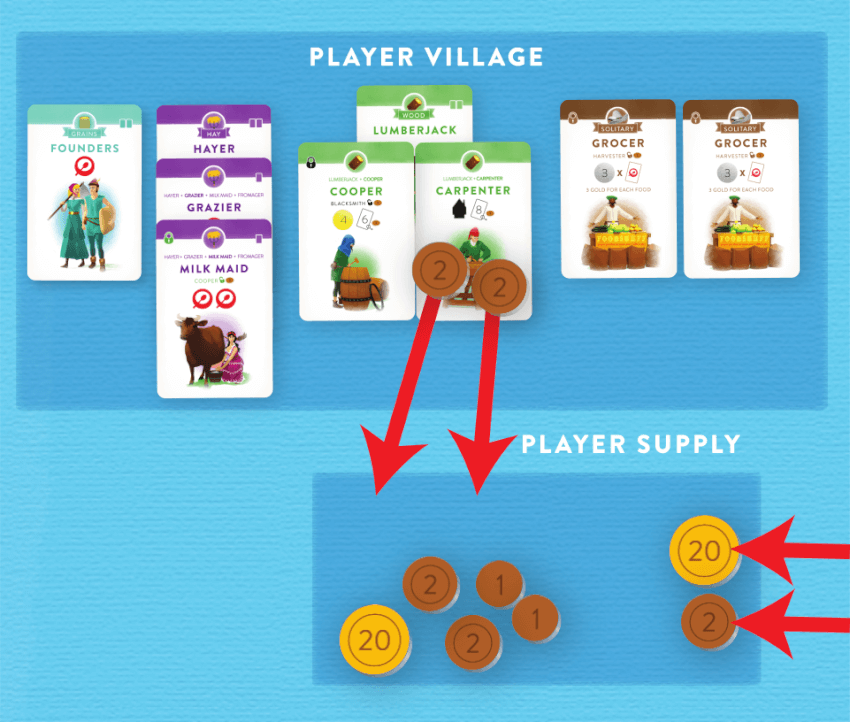
The player has 2 Grocers. Each of them earns 3 Gold for each Food
symbol in the Village. So they earn 9 Gold each. In addition there are
4 Gold printed on the villager cards in the Village. The player takes a
total of 22 Gold from the Bank (9+9+4). Finally the coins on the
Carpenter are moved to the Supply to be included in the final scoring.
Now all that remains is to count up the Gold in the Supply and
compare the score with the other players to determine the winner of
the game.
A game against The Countess is set up like a 2-player game, except:
- Remove all cards from the Special suit.
- Each stack on the road starts with 5 instead of 4 cards.
- The player gets one Jester card.
- The Countess starts with her own card in play instead of a Founders.
- The Countess starts with 1 Gold, and has no hand of cards.
-
Shuffle the Winter Events and the Summer Events in separate
stacks and deal one Summer Event face-up next to the Road.
The Countess is the last living relative of the oppressive Royal Family
that used to rule the land. Using her vast fortune and army of soldiers
she seeks to restore the nobility to their former glory days, with
herself as Queen. She will use everything in her arsenal to stop the
local villagers from organizing on their own. What she lacks in
goodwill from the people and economic skills she makes up for with
bribery, dirty tricks and violence.
The Solo Mode is a way of playing Villagers with just one player. It
uses two decks of events and some simple rules changes to simulate
playing against an evil Countess. Though you have the advantage of
controlling what villagers will end up in each Village, you must react
to disastrous Events every round, adapting your strategy around
them.
Set up the game like a 2 player game, except:
- Remove all cards from the Special suit.
- There are 5 cards in each stack on the road instead of 4.
- Place the Jester card next to your Village Square.
-
Shuffle the Winter Events and the Summer Events in separate
stacks and place them face-down on the table. Deal the top
Summer Event face-up next to the Road.
This Event card will be in play the
first round of the game.
-
Replace one player with The Countess:
-
The Countess Card forms the start of her Village instead of a
Founders card. Place it with the side showing 4 Gold facing up.
- The Countess has 1 gold in her Supply.
- The Countess does not have a hand of cards.
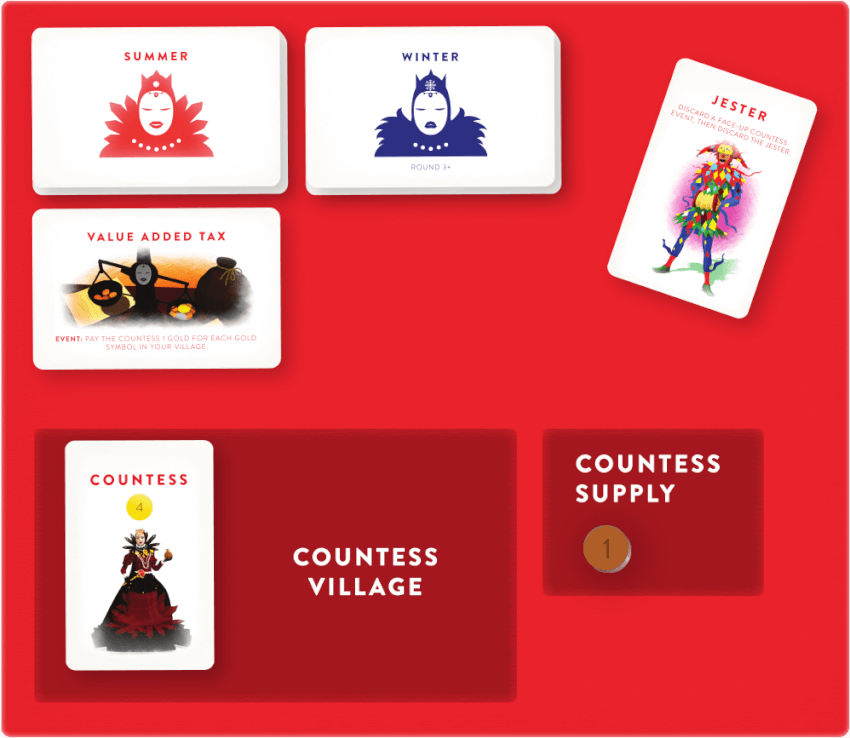
SOLO MODE RULES
The Solo Mode follows the same rules as a 2 player game, but as
there is only one player playing there are some additional rules for
each phase:
DRAFT PHASE
Whenever you draft a card from the Road, also place a face-up
villager of your choice from the Road into the Countess Village.
This is done before dealing new
face-up cards to the Road from the Stacks.
The Countess places all villagers individually, ignores the Padlock mechanic
when placing, and does not put Gold on the Road at the end of the Draft Phase.
You are still required to pay her villagers to unlock your own Padlocks, as per normal rules.
Whenever you draft a card from the Road, also place a face-up
villager of your choice from the Road into the Countess Village
(The Countess builds in the Draft Phase!). This is done before dealing new
face-up cards to the Road from the Stacks.
The villagers placed into the Countess Village ignore the rules for
Production Chains, every villager is placed separately.
The Countess ignores the Padlock mechanic when villagers are placed
into her Village. You still have to pay her villagers to unlock any
villagers you play with Padlocks, as per the normal rules for Padlocks.
She counts as another player in that regard.
Resolve the End of Draft Phase as you would in a 2-player game,
except The Countess does not place Gold on any villager on the Road.
If The Countess for any reason gets a villager you placed Gold on
during the end of a Draft Phase, she gets the coin(s) placed on it to
her Supply.
EVENT PHASE
After the Build Phase and before any Market Phases, resolve the Event Phase.
In any order, resolve all the face-up Events and discard them. Some Events
affect other phases instead of being resolved in the Event Phase; they are simply
discarded in this phase.
After all Events have been resolved, The Countess takes the top card of the
Reserve into her village.
Then deal a number of new Event cards face-up based on the Gold/Silver value of that villager:
- 1, if the villager has a value of 10 Gold or more
- 2, if the villager has a value between 1 and 9 Gold
- 3, if the villager is worth 0 Gold
After finishing the Build Phase, resolve the Event Phase. If there is a
Market Phase in the current round, it is resolved after the Event Phase.
Carry out the following steps in order:
-
Resolve all the face-up Events. Carry out the effects stated on the
cards. You can resolve them in any order you like. Discard the Events
as you resolve them. Some Events have rules that apply in a specific
phase of the game instead of being resolved in the Event Phase.
These cards are also discarded in this phase.
-
When all Events have been resolved, The Countess takes the top
card of the Reserve and places it in her village. This is done just like
in the Draft Phase, ignoring the normal rules for Production Chains
and Padlocks.
Depending on the Gold/Silver value of this villager, a number of new
Event cards will be dealt:
- If the villager has a value of 10 Gold or more, deal 1 Event card.
- If the villager has a value between 1 and 9 Gold, deal 2 Event cards.
- If the villager is worth 0 gold, deal 3 Event cards.
If the villager has a Silver Symbol, calculate its current Gold value
and deal Event cards according to the rules above.
Example: If the villager is an Ore Muler that is currently worth 9 Gold because
The Countess has 6 Ore Symbols in her village, you deal 2 Event cards.
SOLO DRAFT PHASE EXAMPLE
The player drafts a villager, then places a face-up villager from the
Road into the Countess Village. After this, two new cards will be dealt
from the leftmost stack on the Road. As the player has 1 Food, this
process must be done 3 times this round.
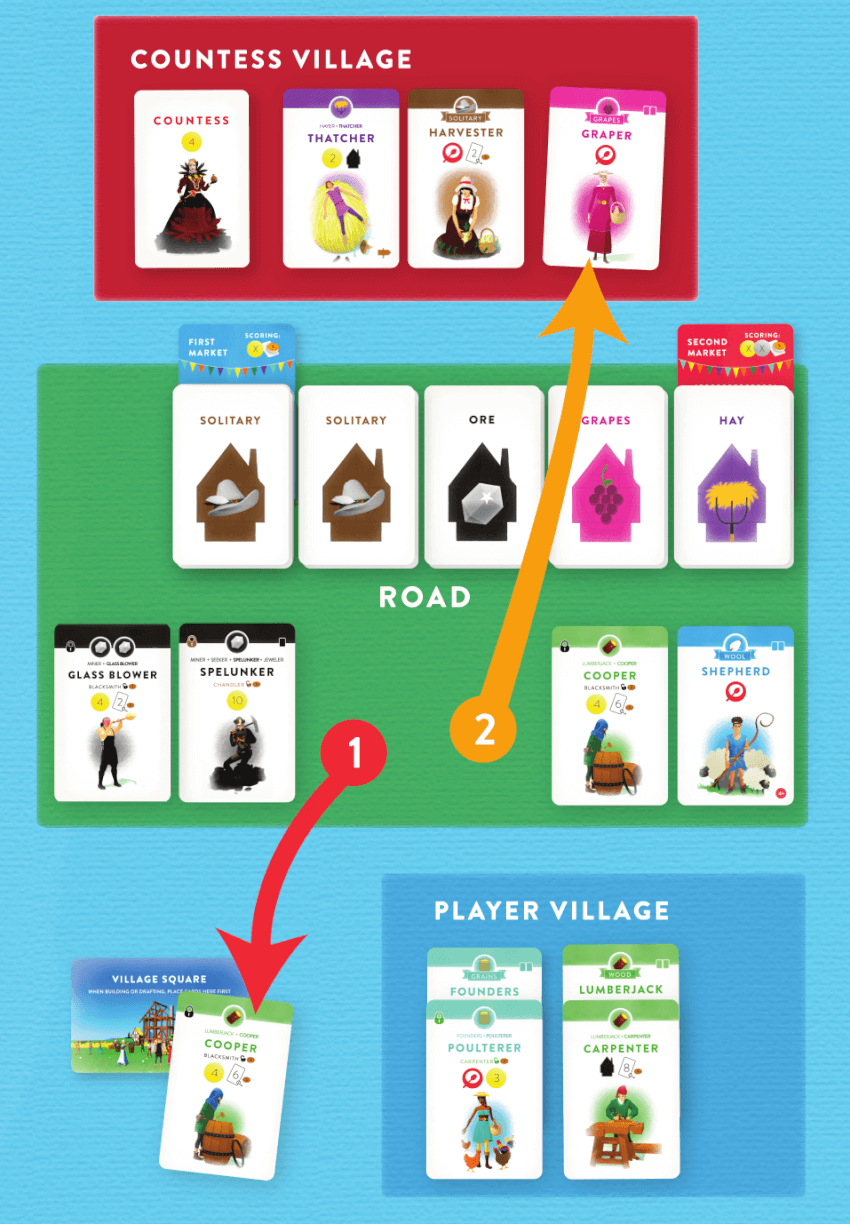
END OF EVENT PHASE EXAMPLE
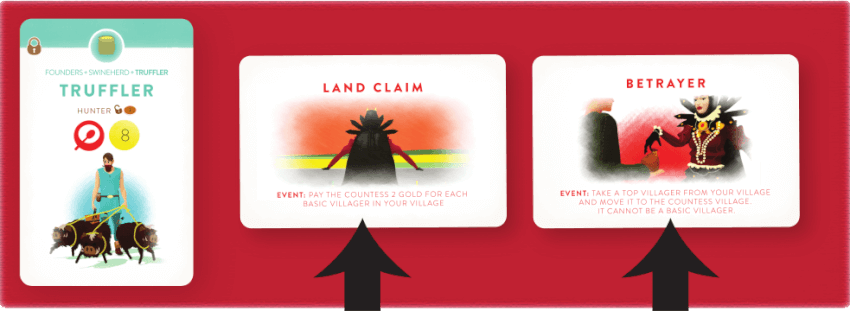
The Countess gets a Truffler at the end of the Event Phase. It’s worth
8 Gold, so 2 new Event cards are dealt.
SWITCHING FROM SUMMER TO WINTER EVENTS
Events are dealt face-up from the Summer Events deck until the First
Market Phase has been resolved. In the rounds after it has been
resolved, they're dealt from the Winter Events deck.
THE JESTER
The Jester can be played at any time to discard an Event (that has not begun to be resolved), but can only be used once.
The Jester belongs to the player and can be played at any time. As
described on his card, he allows you to immediately discard an Event.
He cannot be used to discard an Event that has already been resolved
or is in the middle of being resolved (when The Countess gets a
face-down card from the Conscription event for example, you cannot
discard the Event after looking at the card!). He is discarded after use,
so can only be used once. The Jester is not in the player's hand, and
so cannot be traded in for a Basic Villager.
MARKET PHASES
The Countess scores exactly like a player in the Market Phases
(including Silver Symbols in the Second Market Phase). The Gold on
the Countess Card is included in the scoring.
THE FINAL ROUND
In the final round, when the Second Market Phase (and the end of
the game) has been triggered, the Countess does not place the top
card of the Reserve into her Village.
WINNING THE GAME
You win if you have more Gold than The Countess in your Supply at
the end of the game.
BEGINNER MODE
For a more forgiving game (recommended if playing for the first
time!), make the following changes:
-
Only deal 1 Event each round, regardless of what villager
The Countess gets at the end of the Event Phase.
- Flip the Countess Card over to the side that has no Gold on it.
- Remove the "-It Was You!" Event card from the Winter Events.
HARD MODE
For a more challenging game, make the following changes:
- Deal 2 Event cards at the beginning of the game instead of 1.
- Remove the Jester from the game.
- Remove the "-It Was You!" Event from the Winter Events.
- Give The Countess 10 starting Gold instead of 1.
ADDITIONAL SOLO MODE RULES
If you want to get a solo game going quickly, you can skip reading the
rules on this page and just start playing, then look things up here
while playing.
RUNNING OUT OF EVENTS
If you manage to run out of Events in a deck (Summer or Winter),
shuffle the discarded Events and create a new stack from them.
EVENTS IN OTHER PHASES
Most events do nothing until they are resolved in the Event Phase.
The text on these events all start with the word Event in bold letters.
Other events affect specific phases of the game, specified in bold
letters on the cards. These events have an effect that will remain in
play during the specified phase of the upcoming round. The Rats
event for example will affect the upcoming Draft Phase. If you get an
event like this at the beginning of the game, it will be in play during
the first round.
EVENTS AFFECTING THE ROAD
Some Events let The Countess take villagers from the Road. If it's a
face-up card, replace it with one from the leftmost Stack as you
would in the Draft Phase. Cards being acquired from The Road in the
Event Phase can trigger the Market Phases (and the end of the
game!).
EMPTY RESERVE
If you need to draw a villager from the Reserve after it has run out, if
you have the Conscription event in the final round for example,
shuffle the Discard Pile to create a new Reserve from it.
VILLAGERS WITH COINS
Sometimes The Countess will steal villagers from your Village. If they
have any coins placed on them, they will go to your Supply.
THE FOUNDERS
Your Founders cannot be removed from your Village by Events.
RUNNING OUT OF GOLD
Many events make you pay gold to the Bank or The Countess. If you
don't have enough Gold to pay, you simply pay as much as you can.
If you run completely out of Gold you don't have to pay anything.
KICKSTARTER EXPANSION PACK
The expansions in the Kickstarter Expansion Pack are not
recommended for use with this solo mode, as they’re not balanced
for it. Having said that, it can be fun to houserule and add parts of
the expansions anyway. Perhaps you want an easier game and give
yourself a Scoundrel and a Saint. And maybe try to compete with
The Countess for a Development or two?

SCOUNDRELS EXPANSION
Most villagers are honest hard working people. Some are just hard working.
Note: Scoundrels is not available in the German edition. The card images are thus only in English.
Yucata does not implement the card
Courier, so
Scoundrels can only be played with at most 4 players.
This expansion contains 9 Special Villagers with a moon
symbol in their bottom right corner. If playing with 3 or fewer
players, the two Thieves and Sheriffs are not included in the
game.
When playing with the Scoundrels shuffle the Sheriffs and
Thieves into the main stack of villagers before dealing starting
hands and setting up the Road. Deal each player one of the
remaining Scoundrels villagers, in addition to the 5 villagers
they normally start with in their hands. Return any remaining
Scoundrels villagers to the box. The villagers in this expansion
work just like other Special Villagers.
This expansion is not recommended for players who dislike
interfering with each other’s villages.
Draft Phase: Some of these new Special Villagers are used in
the Draft Phase instead of the Build Phase.

PROFITEERS EXPANSION
Don't worry, I just need one gold. A day.
This expansion contains 8 villagers with a money pouch
symbol in their bottom right corner.
When playing with the Profiteers, mix the 8 Profiteers villagers
into the main stack of villagers before dealing starting hands
and setting up the Road.
 BRONZE SYMBOLS
BRONZE SYMBOLS
This expansion introduces a new mechanic: bronze symbols.
They work just like the Silver Symbols scoring you an amount
of gold depending on what you have in your village. But
instead of only scoring in the Second Market Phase, the
Bronze Symbols score at the end of every Build Phase. This includes
the round when the villager with the symbol was built.
You're only allowed to score 1 Bronze Symbol each round.
On Yucata.de, the largest value is automatically chosen.
Per the designer, each player scores 1 Bronze Symbol at the end of their turn in the Build Phase. Older games on Yucata that score Bronze symbols at the end of the Build Phase instead will continue to do that to be consistent throughout.
DEVELOPMENTS EXPANSION
The Developments Expansion contains 3 Development Suits each with 4 cards.
Setup: Draw one random Development from each suit and place them face up next to the Road
along with their respective Development Tokens.
A Development Phase occurs after every Build Phase (and before any Market Phase), in which
the following occurs:
- Determine the winners of each Development according to the conditions on the cards, and distribute the tokens to the winners.
If there is a tie for a Development, there is no winner.
- Players take their rewards in turn order. (Food and Builder rewards are taken the following turn.)
Scattered across the land are abandoned buildings and
places that used to be important institutions. As the land
is rebuilding itself with the new villages, some people are
restoring the developments of the old golden age, and
already starting to make a living of them. The villages that
provide the most business to these developments will get
rewarded for being good customers.
This expansion contains 12 Development Cards divided
into 3 suits: Technology, Mercantile and Community.
There are also 3 Development Tokens, one matching each
Development Suit.
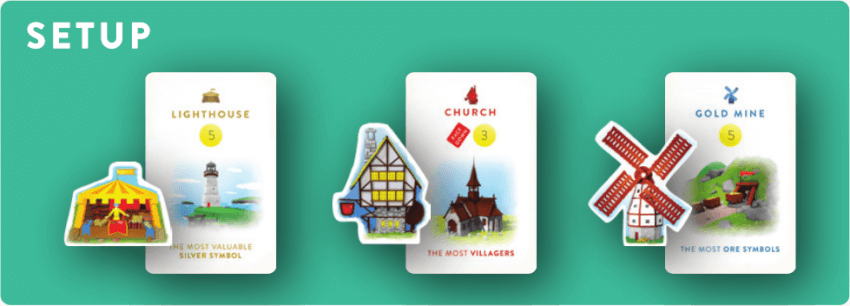
Setup: When using the Developments, draw one random
Development from each suit and place them face up next
to the Road, so that you have 1 Technology, 1 Mercantile
and 1 Community Development. Place the corresponding
Development Tokens next to these cards, the Windmill
next to the Technology card, the Market Stall next to the
Mercantile card and the Tavern next to the Community
card.
DEVELOPMENT PHASE
After every Build Phase, before any Market Phases, there is
now also a Development Phase. In this phase players check
which player wins each Development. There is a win
condition on each Development, and a reward that will be
given to the winner. The Marketplace for example gives 5
Gold to the player who has the most Food. If players are
tied for the win condition, no one gets the reward.
Resolve the Development Phase in the following order:
-
Determine who won each Development in any order,
and give each winner the corresponding Development Token.
If there is a tie for a token, return it to its card.
-
Each winner takes their reward. Gold is paid out from
the Bank immediately. Rewards that give you a villager are
also taken immediately. Food and Builder rewards can be
used in the following round, though you may not exceed
the maximum cap of 5 Build or Draft Actions.
This method of determining who won all the developments
before taking the rewards prevents players from using
their reward to affect the results of other Developments
(some Developments let you get an extra villager for
example).
The Gold on the Developments are not scored in the
Market Phases, and the symbols on the Developments are
not included when scoring the Silver and Bronze Symbols in
your Village.
SUITS
 Wood,
Wood,  Hay,
Hay,  Ore: All villagers in these suits are parts of
production chains starting with the Basic Villagers. These make
up almost half the villagers on the Road. Tip: focus on one of
these suits.
Ore: All villagers in these suits are parts of
production chains starting with the Basic Villagers. These make
up almost half the villagers on the Road. Tip: focus on one of
these suits.
 Grapes,
Grapes,  Wool and
Wool and  Leather: There are just a few villagers in each
of these suits, and instead of starting with Basic Villagers the first
cards in their production chains must be drafted from the Road.
Tip: if you’ve started collecting these, draft more of them
face-down.
Leather: There are just a few villagers in each
of these suits, and instead of starting with Basic Villagers the first
cards in their production chains must be drafted from the Road.
Tip: if you’ve started collecting these, draft more of them
face-down.
 Grains: These villagers form production chains starting with the
Founders. Remember you can only have 2 villagers on top of the
Founders! Tip: all of these provide Food.
Grains: These villagers form production chains starting with the
Founders. Remember you can only have 2 villagers on top of the
Founders! Tip: all of these provide Food.
 Solitary: These villagers do not form Production Chains, instead
they can be placed on their own.
Solitary: These villagers do not form Production Chains, instead
they can be placed on their own.
 Special: These have special rules. Remember that those that are
discarded don’t cost any build actions to use. Tip: if you don’t
know what to draft from the Road, draft a face-down Special, it
will probably be useful.
Special: These have special rules. Remember that those that are
discarded don’t cost any build actions to use. Tip: if you don’t
know what to draft from the Road, draft a face-down Special, it
will probably be useful.
CLARIFICATIONS
Top Villagers: Some Special villagers and Solo Mode Events refer to Top
Villagers. A Top Villager is a villager in your Village with no other villagers
placed on top of it. This includes any villagers with no cards beneath them, like
Solitary villagers for example.
Horse Trader, Log Rafter, Priest: These include their own Suit Symbols when
scored. Some villagers have two Suit Symbols, this makes them more valuable
when scoring these.
Ox Crane, Windmill, Sawmill (Developments): As the Development Tokens don't change
hands until the Development Phase, you get to keep and use the extra
Food/Builder until that phase, even if another player has beaten you
for the condition to get it before then.
Villagers Base Set Cards
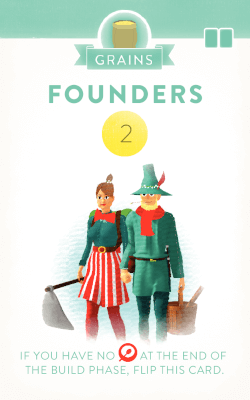
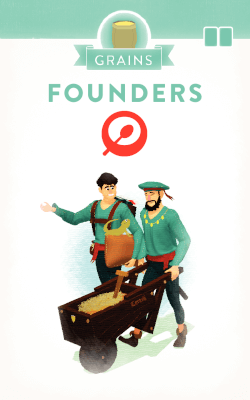
Founders
Founders start the
Grain suit Production Chain.
Founders are double-sided. Each player starts with a Founders in their Village, the 2-Gold side face up. It will turn to the Food side if a player has no Food at the end of the Build Phase.
Each player has a different illustration for their Founders. There are no functional differences between them.
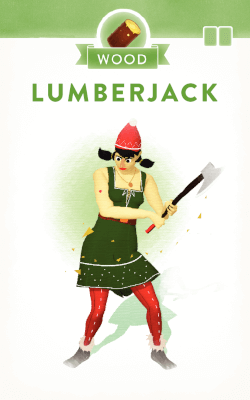
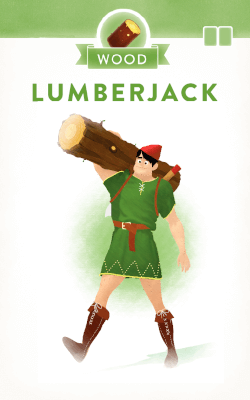
Lumberjack
Lumberjacks are Basic Villagers that start the
Wood suit Production Chains.
Basic Villagers are double-sided with different illustrations (male and female). You can choose which side is shown for all Basic Villagers in Preferences.
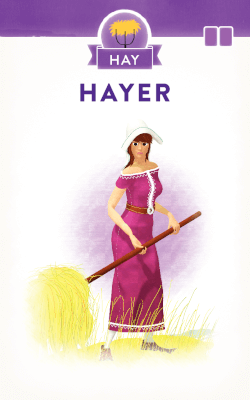
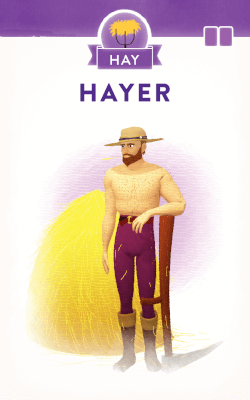
Hayer
Hayers are Basic Villagers that start the
Hay suit Production Chains.
Basic Villagers are double-sided with different illustrations (male and female). You can choose which side is shown for all Basic Villagers in Preferences.
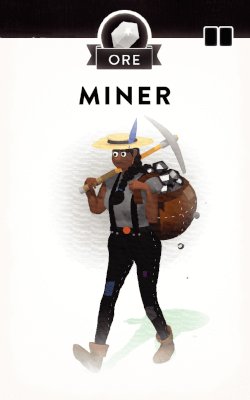
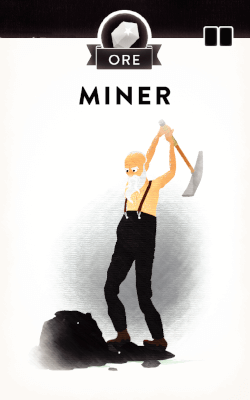
Miner
Miners are Basic Villagers that start the
Ore suit Production Chains.
Basic Villagers are double-sided with different illustrations (male and female). You can choose which side is shown for all Basic Villagers in Preferences.

Log Rafter
2 Wood Symbols
Silver scoring: 1 Gold per Wood Symbol
Played on:
Lumberjack

Wood Carver
Silver scoring: Sum of all Gold symbols printed on your Wood villagers
Played on:
Lumberjack
Clarification:
The Wood Carver scores the total value of all Gold Symbols on your
Wood Villagers. If you have 1 Cartwright and a Cooper for example your Wood
Carver will earn 13 Gold.

Bed Builder
4 Gold, 2 Hay Symbols
Played on:
Hayer
Unlocked by:
Carpenter
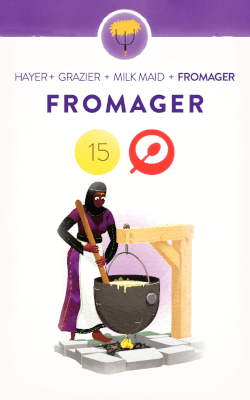
Fromager
1 Food, 15 Gold
Played on:
Milk Maid
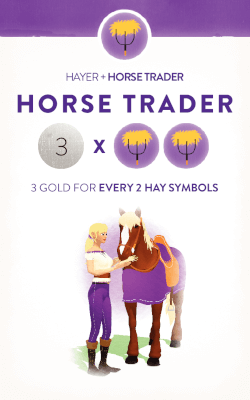
Horse Trader
Silver scoring: 3 Gold for every 2 Hay Symbols (rounded down)
Played on:
Hayer

Ore Muler
Silver scoring: 3 Gold for every 2 Ore symbols (rounded down)
Played on:
Hayer
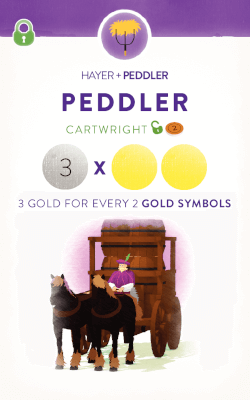
Peddler
Silver scoring: 3 Gold for every 2 Gold symbols (rounded down)
Played on:
Hayer
Unlocked by:
Cartwright
Clarification:
The Peddler gives you 3 gold for every 2 Gold Symbols, not every 2
Gold. If for example the only Gold Symbols in your Village are on two Jewelers,
each giving 20 Gold, a Peddler will score just 3 Gold.
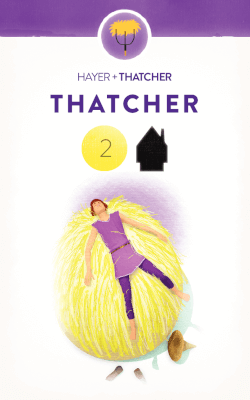
Thatcher
1 Builder, 2 Gold
Played on:
Hayer
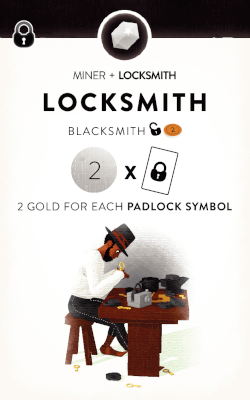
Locksmith
Silver scoring: 2 Gold for each Padlock Symbol
Played on:
Miner
Unlocked by:
Blacksmith
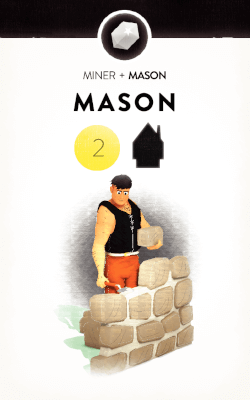
Mason
1 Builder, 2 Gold
Played on:
Miner
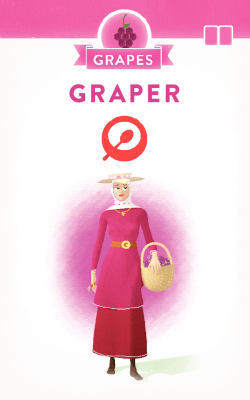
Graper
1 Food
Starts the Grape suit Production Chain
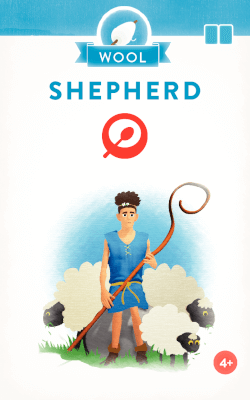
Shepherd
1 Food
Starts the Wool suit Production Chain
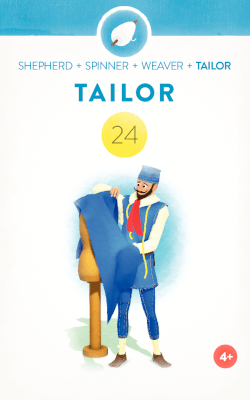
Tailor
24 Gold
Played on:
Weaver
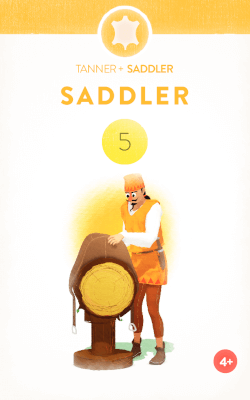
Saddler
5 Gold
Played on:
Tanner
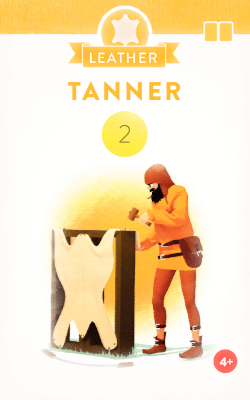
Tanner
2 Gold
Starts the Leather suit Production Chain
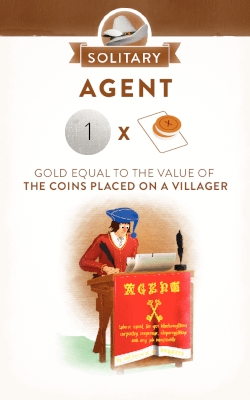
Agent
Silver scoring: Gold equal to the value of coins placed on one villager
Clarification:
The Agent scores as much as the Gold value of the
coins placed on one of your villagers. You choose which one.
On Yucata.de, the largest value is automatically chosen.

Freemason
Silver scoring: 3 Gold for each Builder
Unlocked by:
Brewer

Grocer
Silver scoring: 3 Gold for each Food
Unlocked by:
Harvester
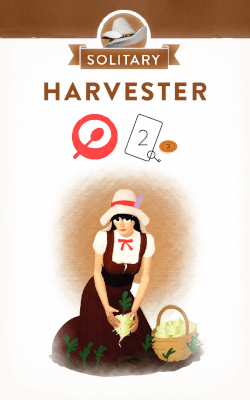
Harvester
1 Food
Unlocks: Grocer
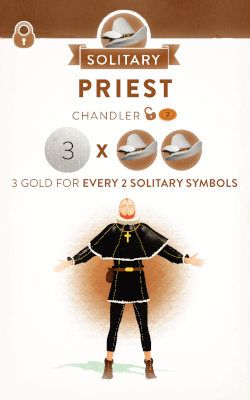
Priest
Silver scoring: 3 Gold for every 2 Solitary Symbols (rounded down)
Unlocked by:
Chandler
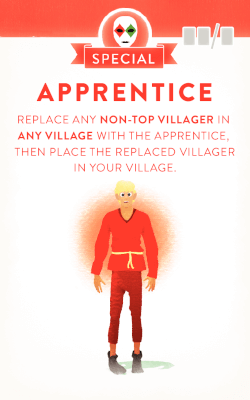
Apprentice
Replace any non-Top villager in any village with the Apprentice,
then place the replaced villager in your Village.
Clarification:
The Apprentice can swap places with any villager in any Village
that is covered by another card in its Production Chain. He can be used in other
player's Villages, or in your own. The card he swaps places with must then be
placed in your Village immediately, following the normal rules for placing
Villagers. Using the Apprentice only uses up one build action, not two. Though
the Apprentice cannot be used to steal another player's Founders (as stated in
the rules for Special Villagers), he can be used on your own Founders, if they
have at least one card placed on top of them. If you do you can choose which
side of them you place face-up.
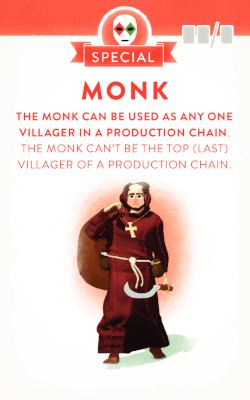
Monk
The Monk can be used as any one villager in a Production Chain.
The Monk can't be the top (last) villager of a Production Chain.
Clarification:
The Monk can be used as any villager, as long as you don't make him
the top card of a Production Chain. This means he will always be placed at the
same time as another villager, with the Monk below the other, taking the role
as one of the villagers in the Production Chain. The Production Chain he is used
in must have all the other cards in correct order. 2 Monks can be used in the
same Production Chain.
Monks and Apprentices: These do not act as the cards they are replacing, they
are simply villagers with no symbols printed on them, except their Suit Symbol,
they belong to the Special suit. Their purpose is to be placed below other
villagers. The next villager in the Production Chain must always be on top of
the Monk or Apprentice. If for any reason, a Monk or an Apprentice becomes
the top card of a Production Chain, it returns back to the hand of the player
whose village it was in.
If an Apprentice or Monk is the bottom card of a Production Chain, it can have
2 cards on top. They must be of the same suit.
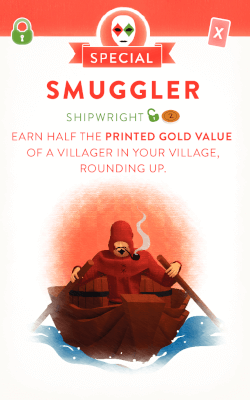
Smuggler
Earn half the printed Gold value of a villager in your Village, rounding up.
Discarded after use
Unlocked by:
Shipwright

Tinner
Unlock any Padlocks on any villagers played together with the Tinner for free.
Discarded after use
Clarification:
The Tinner can unlock several cards even if they have different
unlockers. It does not matter if you or some other player has the Unlocking
Villagers, they can be unlocked for free by the Tinner as long as they’re played
in the same Build Phase. Players are allowed to mix and match, unlocking
some villagers with the Tinner and some without her (to place coins on your
own villagers for example).
Saints Cards
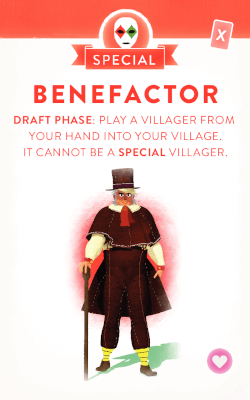
Benefactor
Play during the Draft Phase
Play a villager from your hand into your village. It cannot be a Special villager.
Discarded after use
Clarification:
You cannot trade in a card from your hand to get a Basic
Villager when using the Benefactor, that action must be taken in the
Build Phase.
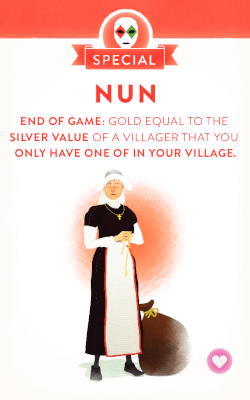
Nun
At the end of the game, awards an amount of Gold equal to the Silver value of a villager that you have exactly one of in your Village.
On Yucata.de, the largest value is automatically chosen.
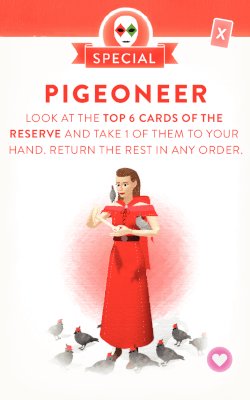
Pigeoneer
Look at the top 6 cards of the Reserve and take 1 of them to your hand. Then return the rest in any order.
Discarded after use
Clarification: After taking the chosen villager to your hand, return the
other villagers to the top of the Reserve in any order.
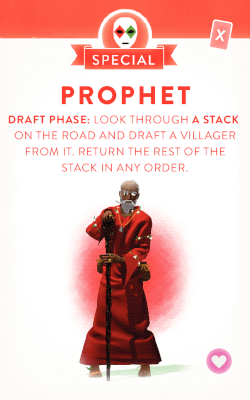
Prophet
Play during the Draft Phase
Look through a stack on the Road and draft a villager from it. Return the rest of the stack in any order.
Discarded after use
Clarification:
The Prophet counts as your Draft for the turn.
The Prophet cannot look through the Reserve, the Pigeoneer
does that. Return the stack to its place on the Road after drafting,
placing the cards in any order in the stack.
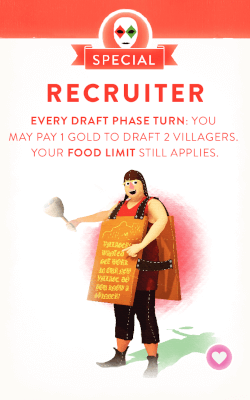
Recruiter
In every Draft Phase turn, you may pay 1 Gold to draft 2 villagers.
Your Food Limit still applies.
Clarification:
When using the Recruiter, replace the face-up card you
drafted on the Road before picking your next card.
On Yucata.de, you decide whether to use the Recruiter at the start of your turn, before your first draft.
On Yucata.de this card is not available in Solo Mode.
Scoundrels Cards
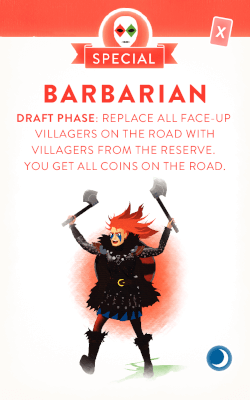
Barbarian
Play during the Draft Phase
Discard all villagers on the Road, taking the coins into your Supply. Replace the villagers with villagers from the Reserve.
Discarded after use
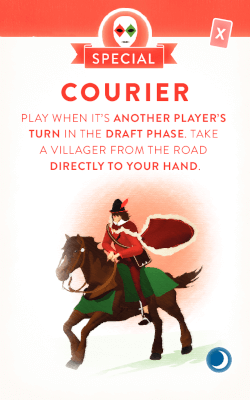
Courier
Play before another player's turn in the Draft Phase.
Take a villager from the road directly to your hand.
Discarded after use
Clarification:
You must use the Courier before the currently playing player has picked up a card from the Road.
Replace the card on the Road with a new one from the leftmost stack as when drafting.
This card is not implemented on Yucata.de; players will never receive it.
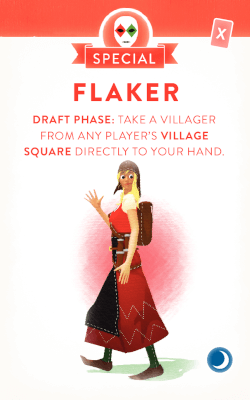
Flaker
Play during the Draft Phase
Take a villager from any player's Village Square directly to your hand.
Discarded after use
Clarification:
You can also use the Flaker on your own Village Square (this
allows you to draft an extra villager as it frees up one Draft Action!)
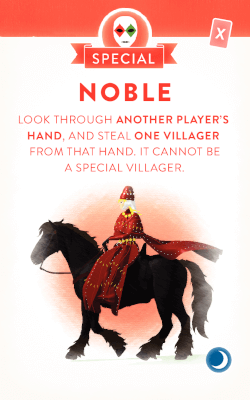
Noble
Look through another player's hand and steal one villager
from that hand. It cannot be a special villager.
Discarded after use
Clarification:
When using the Noble, you do get to look at both sides of the
other player's cards.
On Yucata.de this card is not available in Solo Mode.
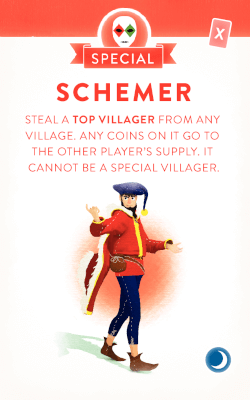
Schemer
Steal a Top Villager from any Village.
Any coins on it go to the owner's Supply.
It cannot be a Special villager.
Discarded after use
Clarification:
Coins on a villager stolen by the Schemer go to the Supply of
the player stolen from. You can also use the Schemer to take one of
your own villagers back to your hand. If it's a villager with coins on it,
the coins go to your Supply.
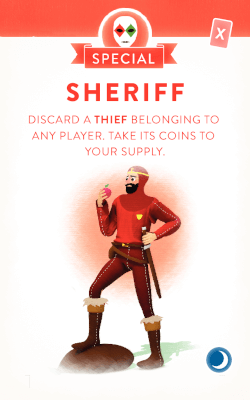
Sheriff
Discard a Thief belonging to any player. Take its coins to your Supply.
Discarded after use
Clarification:
You can also use a Sheriff on your own Thief to get the coins to
your own Supply.
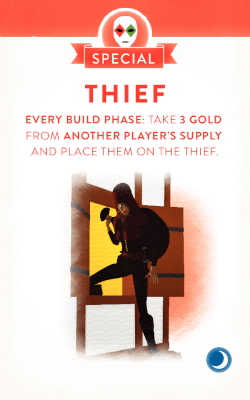
Thief
In every Build Phase, take 3 Gold from another player's Supply
and place them on the Thief.
Clarification:
Coins on the Thief can be scored by other villagers such as the Agent and the Arkwright.
The coins on the Thief are scored in the Market Phases just like other coins on villagers.
You cannot steal coins from a player with less than 3 Gold in their Supply.
You can only steal from another player's Supply, not from Gold placed on their villagers.
Profiteers Cards
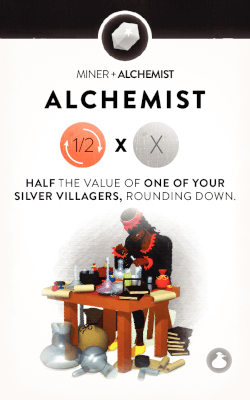
Alchemist
Bronze scoring: Half the value of one of your Silver villagers,
rounding down.
Played on:
Miner
On Yucata.de, the largest value is automatically chosen.
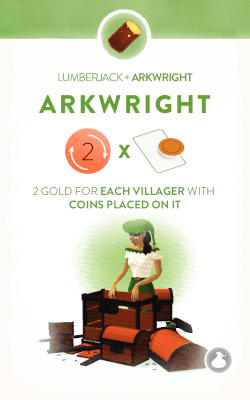
Arkwright
Bronze scoring: 2 Gold for each Villager with any coins placed on it.
Played on:
Lumberjack
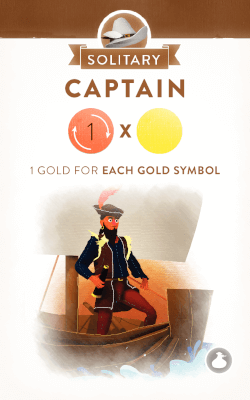
Captain
Bronze scoring: 1 Gold for each Gold Symbol.
The Captain scores 1 Gold for each printed Gold Symbol in
your Village (he does not score for all your Gold or your coins!).
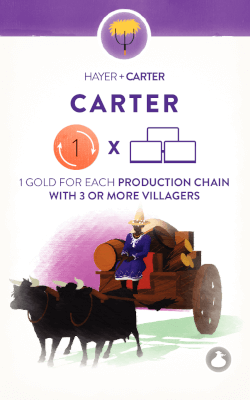
Carter
Bronze scoring: 1 Gold for each Production Chain with 3 or more Villagers.
Played on:
Hayer
The Carter scores 1 Gold for each Production Chain you have
with at least 3 cards. For example a Miner with two Blacksmiths on top
will score 1 Gold with the Carter. Similarly, a Lumberjack with a
Wheeler and Cartwright on top will also score 1 Gold.
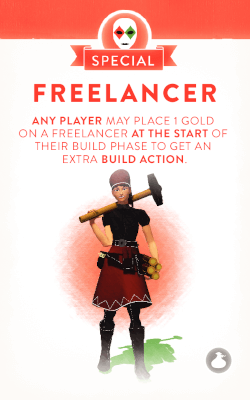
Freelancer
Any player may place 1 Gold on a Freelancer at the start of
their Build Phase to get an extra Build Action.
You can also pay your own Freelancer to get an extra Build
Action. Each player can only pay each Freelancer once in each Build
Phase. If both Freelancers are present, a player may choose to pay
both, to get 2 extra Build Actions. The maximum of 5 Build Actions still
applies.
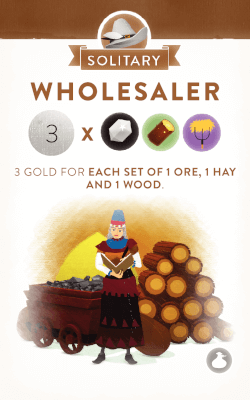
Wholesaler
Silver scoring: 3 Gold for each set of 1 Ore, 1 Hay and 1 Wood Symbol.
Developments Cards
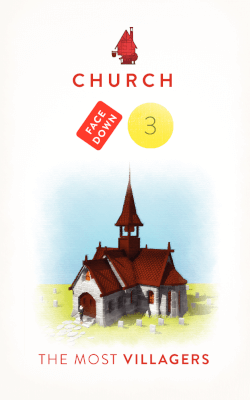
Church
Condition: the most Villagers
Reward: 3 Gold, and one face-down card taken from any stack or the Reserve into your hand
Clarification:
The winner is the player with the most villagers in their
Village. So you count the number of villagers, not the Suit Symbols. You
may take the top face-down villager from any stack including the Reserve
to your hand. You do not need to reveal what you got.
On Yucata.de this card is not available in Solo Mode.
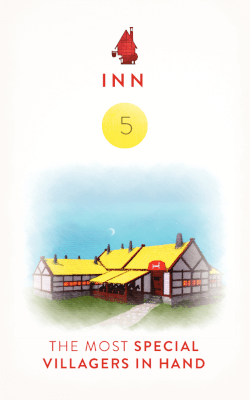
Inn
Condition: the most Special Villagers in hand
Reward: 5 Gold
Clarification:
When checking who won this, show the other players the backs of
the villagers in your hand to show how many Special villagers you have.
It is not necessary to show the fronts.
On Yucata.de this card is not available in Solo Mode.
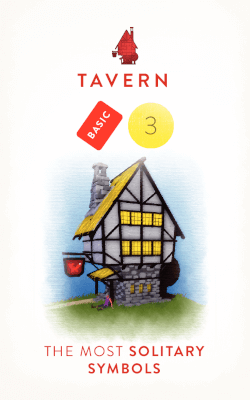
Tavern
Condition: the most Solitary Symbols
Reward: 3 Gold, and take a Basic Villager into your Village
You can take any one Basic Villager, either a Miner, Lumberjack
or Hayer. Place the chosen Basic Villager in your Village immediately.
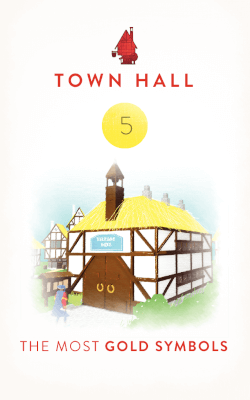
Town Hall
Condition: the most Gold Symbols
Reward: 5 Gold
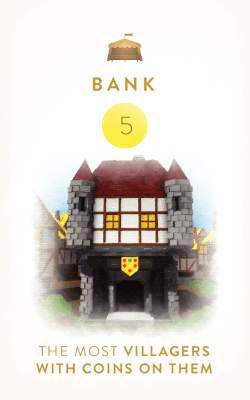
Bank
Condition: the most Villagers with coins on them
Reward: 5 Gold
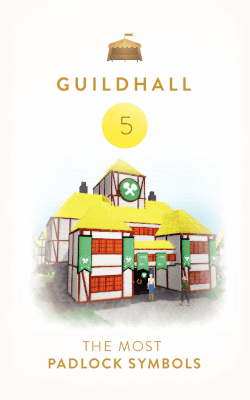
Guildhall
Condition: the most Padlock Symbols
Reward: 5 Gold
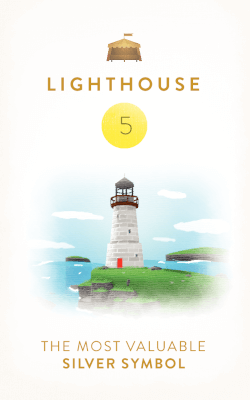
Lighthouse
Condition: the most valuable Silver Symbol
Reward: 5 Gold
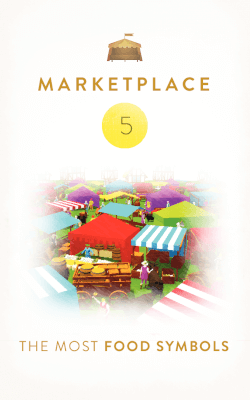
Marketplace
Condition: the most Food Symbols
Reward: 5 Gold
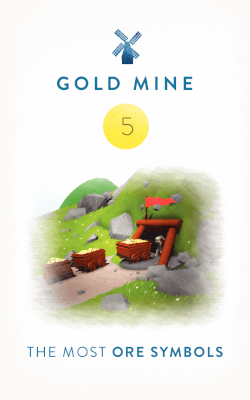
Gold Mine
Condition: the most Ore Symbols
Reward: 5 Gold
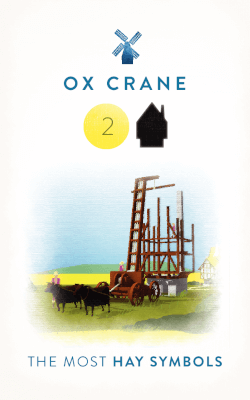
Ox Crane
Condition: the most Hay Symbols
Reward: 2 Gold, 1 Builder
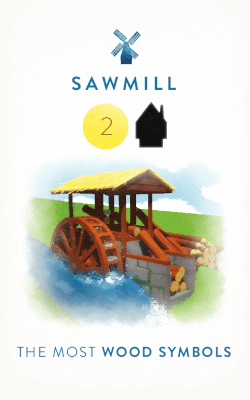
Sawmill
Condition: the most Wood Symbols
Reward: 2 Gold, 1 Builder
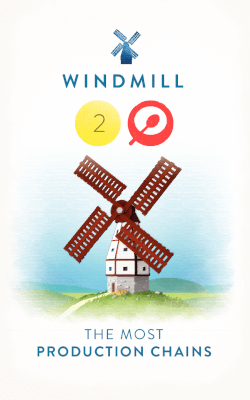
Windmill
Condition: the most Production Chains
Reward: 2 Gold, 1 Food
A Production Chain must have at least 2 cards to count as
one. So the Solitary villagers for example are not included when
checking who won the Windmill.
On Yucata.de this card is not available in Solo Mode.
Solo Mode Cards
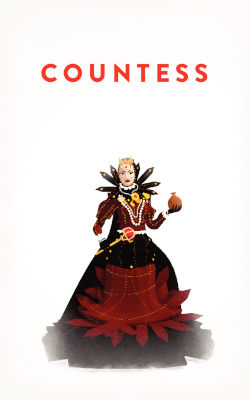
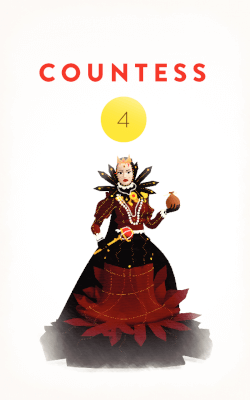
Countess
The Countess village begins with this card instead of a Founders.
4 Gold (except in Beginner Mode)
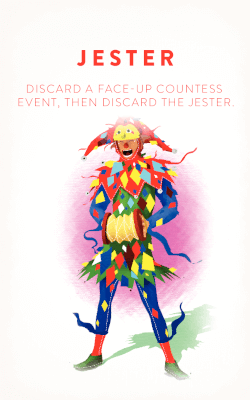
Jester
Once per game, The Jester allows you to discard one Event Card of your choice.
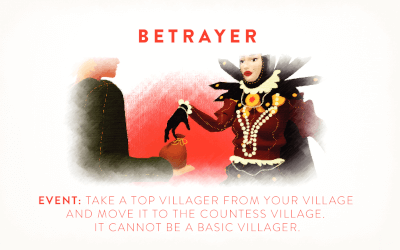
Betrayer
Event: Take a top villager from your village and move it to the Countess village.
It cannot be a Basic villager.
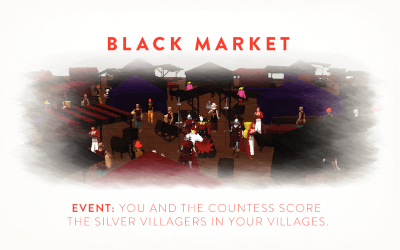
Black Market
Event: You and the Countess score the Silver villagers in your villages.
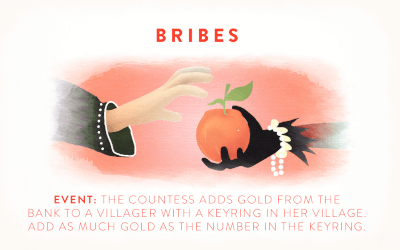
Bribes
Event: The Countess adds Gold from the Bank to a villager with a keyring in her village.
Add as much Gold as the number in the keyring.
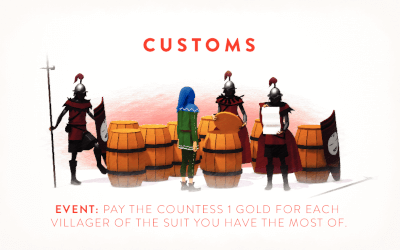
Customs
Event: Pay the Countess 1 Gold for each villager of the suit you have the most of.
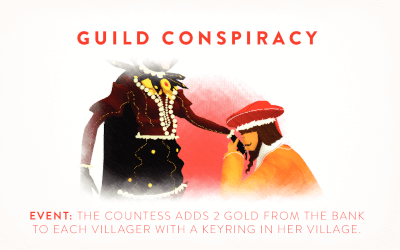
Guild Conspiracy
Event: The Countess adds 2 Gold from the Bank to each villager with a keyring in her village.
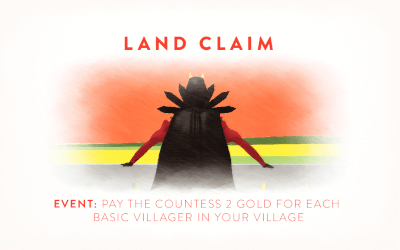
Land Claim
Event: Pay the Countess 2 Gold for each Basic villager in your village.
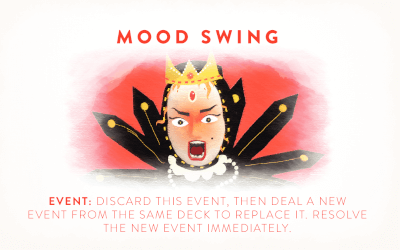
Mood Swing
Event: Discard this Event, then deal a new Event from the same deck to replace it.
Resolve the new Event immediately.
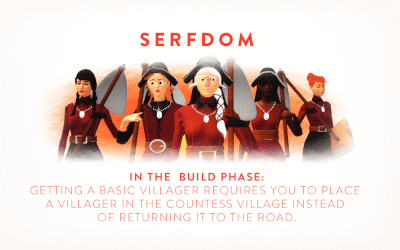
Serfdom
In the Build Phase:
Getting a Basic villager requires you to place a villager in the Countess village
instead of returning it to the Road.
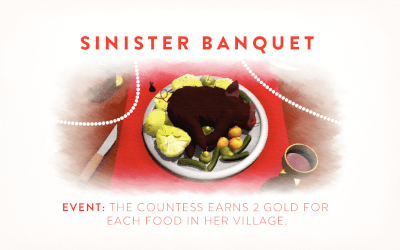
Sinister Banquet
Event: The Countess earns 2 Gold for each Food in her village.
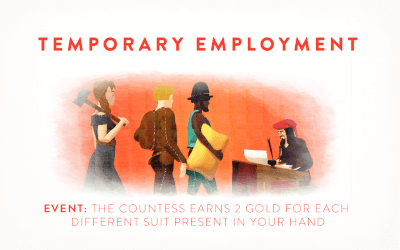
Temporary Employment
Event: The Countess earns 2 Gold for each different suit present in your hand.
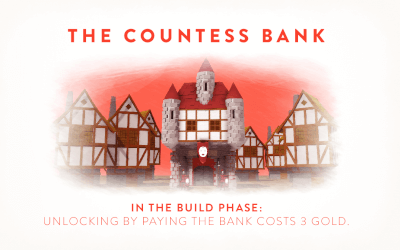
The Countess Bank
In the Build Phase:
Unlocking by paying the Bank costs 3 Gold.
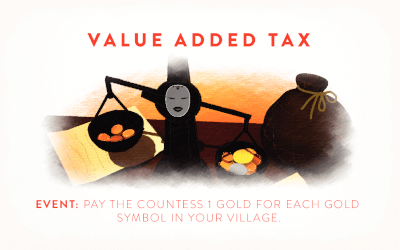
Value Added Tax
Event: Pay the Countess 1 Gold for each Gold symbol in your village.
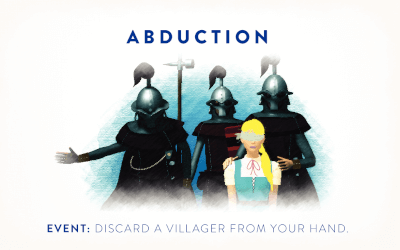
Abduction
Event: Discard a villager from your hand.
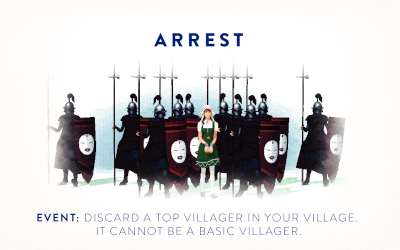
Arrest
Event: Discard a top villager in your village. It cannot be a Basic villager.

Arson
In the Build Phase: 1 less Build action or pay 3 Gold to the Bank.
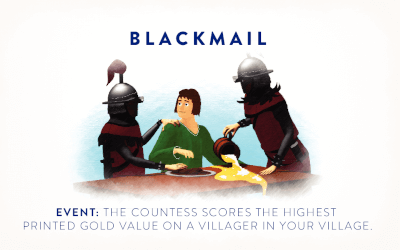
Blackmail
Event: The Countess scores the highest printed Gold value on a villager in your village.
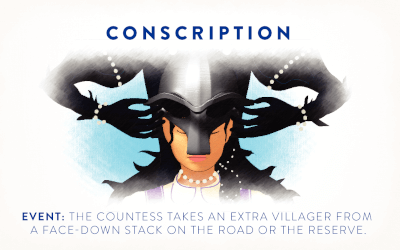
Conscription
Event: The Countess takes an extra villager from a face-down stack on the Road or the Reserve.
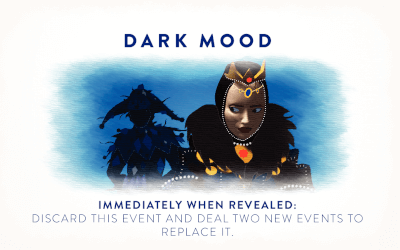
Dark Mood
Immediately when revealed: Discard this event and deal two new events to replace it.
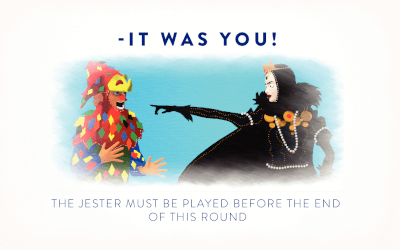
-It Was You!
The Jester must be played before the end of this round.
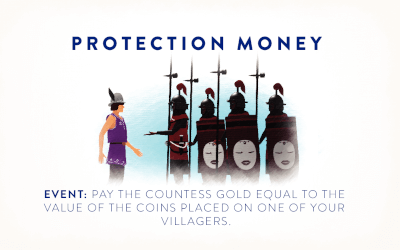
Protection Money
Event: Pay the Countess Gold equal to the value of the coins placed on one of your villagers.
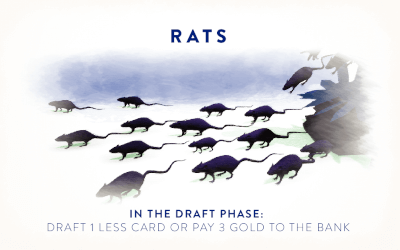
Rats
In the Draft Phase:
Draft 1 less card or pay 3 Gold to the Bank.

Spy Network
Event: The Countess earns the value of one of your Silver symbols.
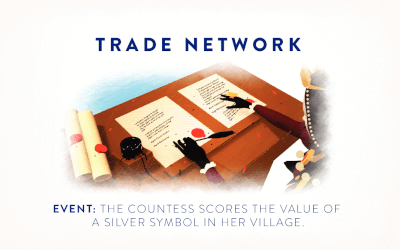
Trade Network
Event: The Countess scores the value of a Silver symbol in her village.
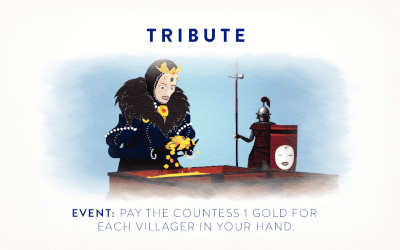
Tribute
Event: Pay the Countess 1 Gold for each villager in your hand.